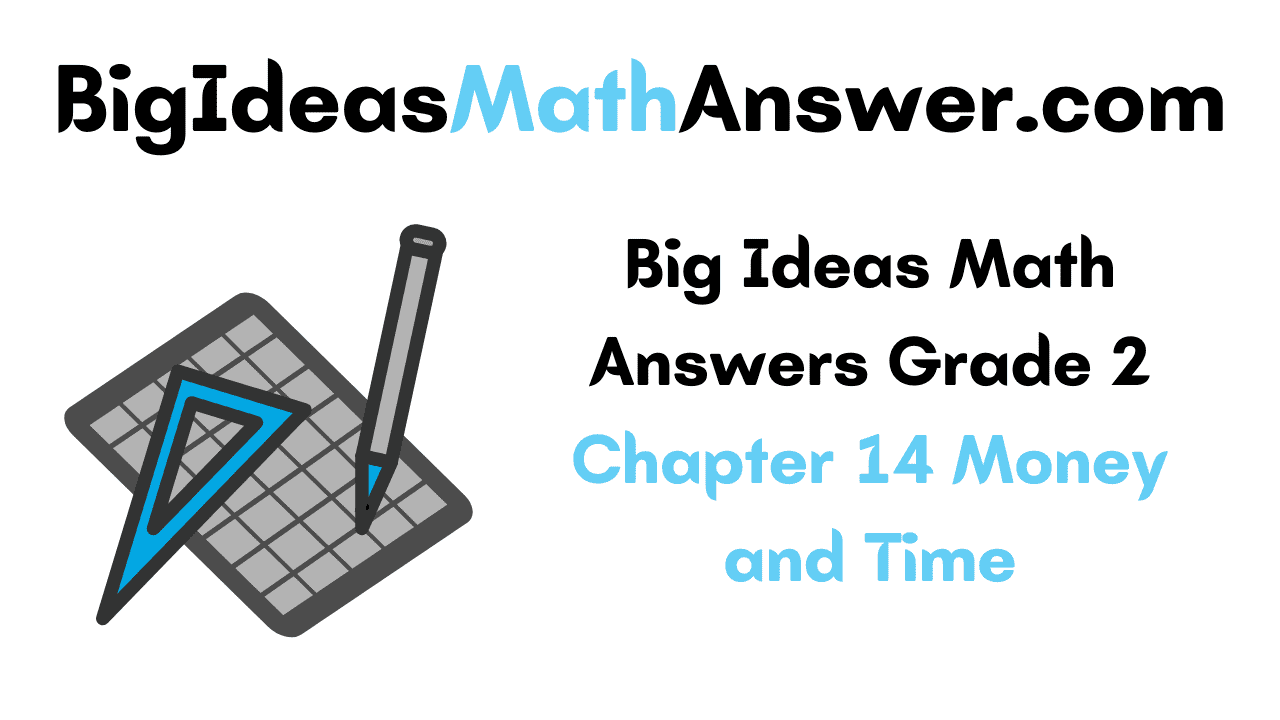Students can find Big Ideas Math Book Grade 2 Chapter 14 Money and Time Answers in the following sections. You can definitely score good marks on the test with the help of the BIM 2nd Grade Book 14th Chapter Money and Time Answer Key. The students can download and practice questions from Big Ideas Math Answers Grade 2 14th Chapter Money and Time PDF for free of cost. It will help you to complete the homework within time.
Big Ideas Math Book 2nd Grade Answer Key Chapter 14 Money and Time
Check out the BIM Book Grade 2 Chapter 14 Money and Time Solution Key and prepare well for the exam. You will see the step by step detailed explanation for each and every question from Big Ideas Math Textbook Grade 2 Chapter 14 Money and Time.
The different topics covered in this chapter are Find Total Values of Coins, Order to Find Total Values of Coins, Show Money Amounts in Different Ways, Make One Dollar, Make Change from One Dollar, Find Total Values of Bills, Problem Solving: Money, Tell Time to the Nearest Five Minutes, Tell Time Before and After the Hour, and Relate A.M. and P.M.
Vocabulary
Lesson: 1 Find Total Values of Coins
Lesson: 2 Order to Find Total Values of Coins
- Lesson 14.2 Order to Find Total Values of Coins
- Order to Find Total Values of Coins Homework & Practice 14.2
Lesson: 3 Show Money Amounts in Different Ways
- Lesson 14.3 Show Money Amounts in Different Ways
- Show Money Amounts in Different Ways Homework & Practice 14.3
Lesson: 4 Make One Dollar
Lesson: 5 Make Change from One Dollar
Lesson: 6 Find Total Values of Bills
Lesson: 7 Problem Solving: Money
Lesson: 8 Tell Time to the Nearest Five Minutes
- Lesson 14.8 Tell Time to the Nearest Five Minutes
- Tell Time to the Nearest Five Minutes Homework & Practice 14.8
Lesson: 9 Tell Time Before and After the Hour
- Lesson 14.9 Tell Time Before and After the Hour
- Tell Time Before and After the Hour Homework & Practice 14.9
Lesson: 10 Relate A.M. and P.M.
Chapter: 10 – Money and Time
Money and Time Vocabulary
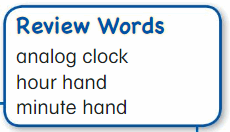
Organize It
Use the review words to complete the graphic organizer.

Answer:
1. Analog clock .
2. The long hand pointing minutes is the minutes hand.
3. The short hand pointing hours is the hour hand.
Define it
Use your vocabulary cards to complete the puzzle.
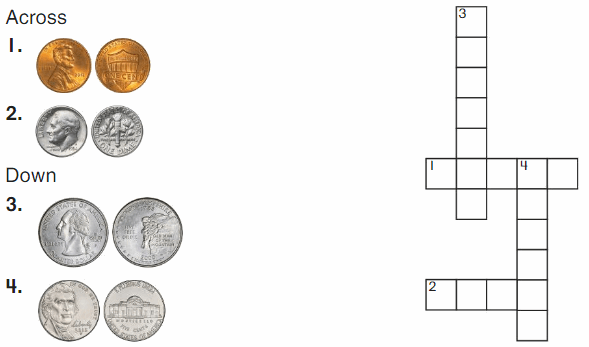
Answer:
1. Penny
2.Dime
3. Quarter
4. Nickel
Chapter 14 Vocabulary Cards
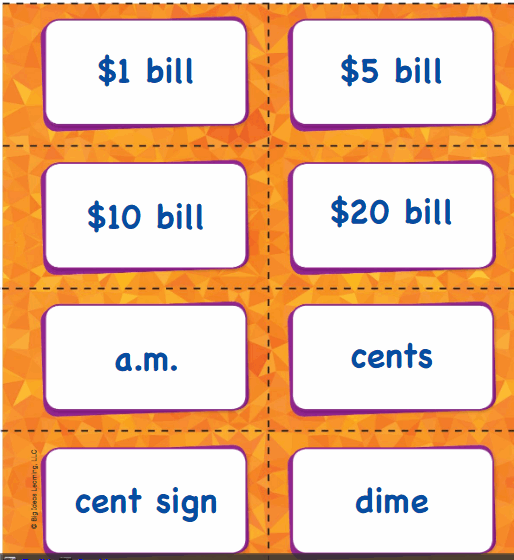
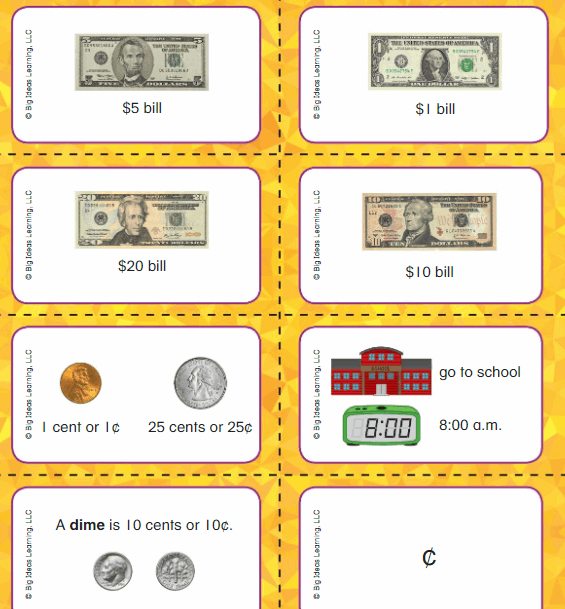
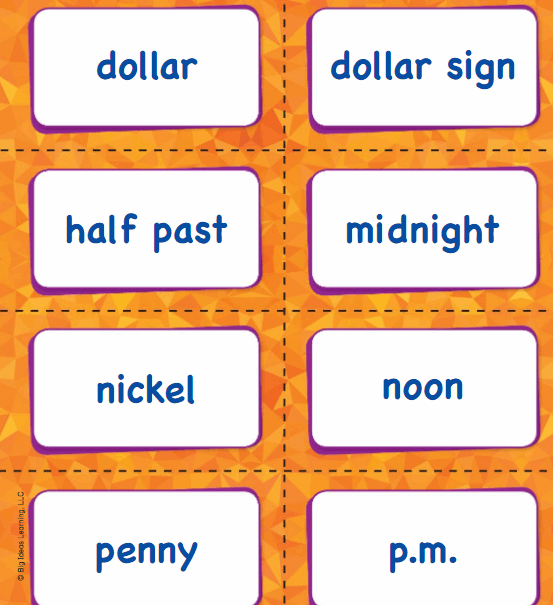
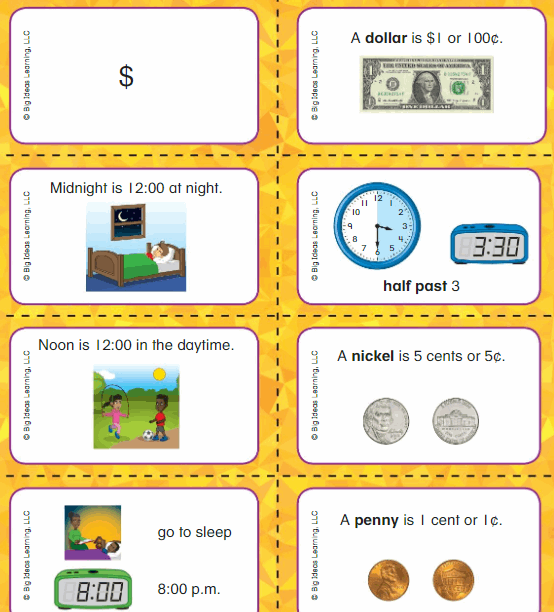
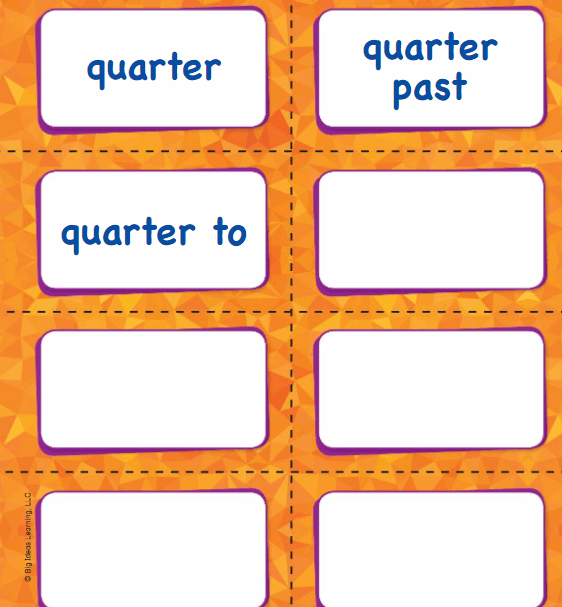
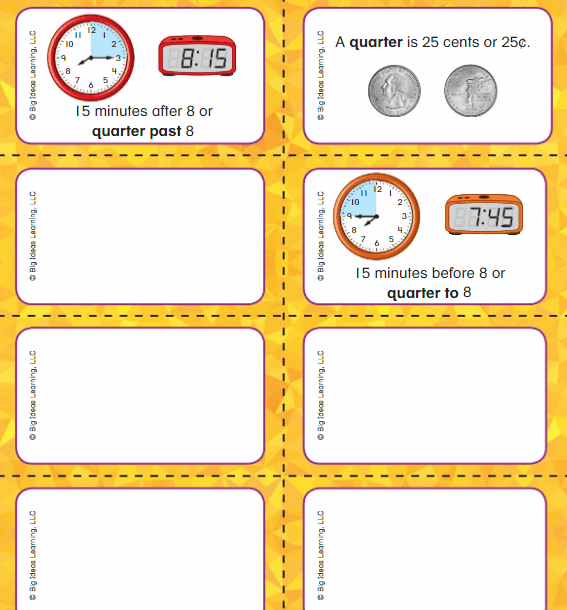
Lesson 14.1 Find Total Values of Coins
Explore and Grow
Sort your coins.
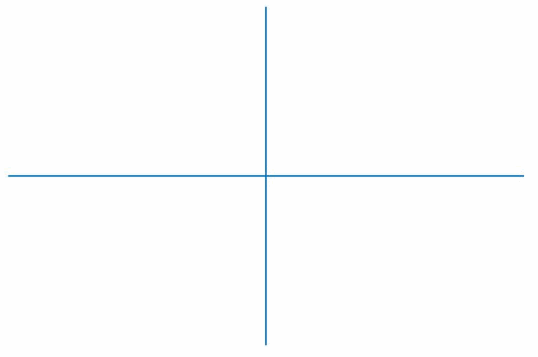
Explain how you sorted.
__________________
__________________
__________________
__________________
Answer:
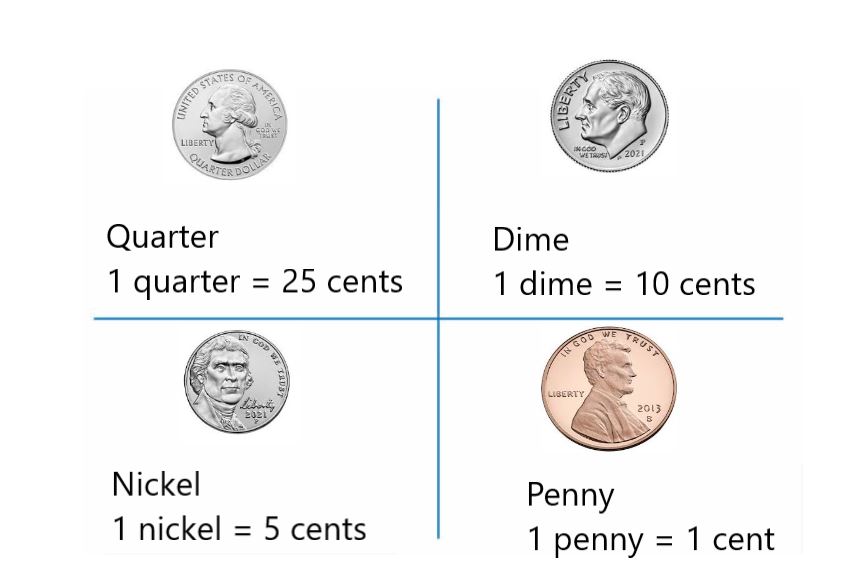
Show and Grow
Count on to find the total value.
Question 1.

Answer:
36 cents
Explanation :
1 dime = 10 cents
That means, 3x 10 = 30 cents
1 nickel = 5 cents
That means, 1x 5= 5 cents
and 1 cent
So , 3 dime +1 nickel+1 cent = 30 cents+ 5 cents +1 cent = 36 cents.
Question 2.

Answer:
42 cents
Explanation:
1 quarter = 25 cents
That means , 1 x25= 25 cents
1 nickel = 5 cents
That means , 3 x 5 = 15 cents & 2 cents additional
Total : 25 cents + 15 cents + 2 cents = 42 cents
Therefore , total value is 42 cents .
Apply and Grow: Practice
Count on to find the total value.
Question 3.

Answer:
55 cents
Explanation :
1 quarter = 25 cents
Which means , 2 x 25 = 50
1 nickel = 5 cents
Total : 50 + 5 =55 cents
Total value of coins is 55 cents.
Question 4.

Answer:
48 cents
Explanation:
1 quarter = 25 cents
1 dime = 10 cents
Which means, 2 x 10 = 20 cents
and 3 cents
Total : 25 +20 +3 = 48 cents
Therefore, Total value is 48 cents.
Question 5.

Answer:
66 cents
Explanation:
1 quarter = 25 cents
1 dime = 10 cents
Which means , 3 x 10 = 30 cents
1 nickel = 5 cents
Which means , 2 x 5 = 10 cents
& 1 cent
Total : 25 +30+ 10 +1=66
Therefore , the total value of coins is 66 cents.
Question 6.
Reasoning
You have 27¢. Which groups of coins could you have?

Answer:

This set of coins have total of 27 cents
Explanation:
1 dime = 10 cents
Which means, 2 x 10 = 20 cents
1nickel = 5 cents
and 2 cents
Total : 20 + 5 + 2 = 27 cents.
Think and Grow: Modeling Real Life
You have 2 quarters, 1 dime, 4 nickels, and 1 penny. How many cents do you have? Do you have enough money to buy the airplane?
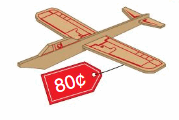

Answer:
I have 81 cents.
Yes, I have enough money to buy the airplane.
Explanation:
1 quarter = 25 cents
So 2 quarters = 25+25 =50 cents
1 dime =10 cents
1 nickel = 5 cents
So 4 nickels = 4 x 5 = 20 cents
1 penny =1 cent
Total amount is 50+10+20+1 =81 cents
The airplane costs 80 cents so, I have enough money to buy the plain.
Show and Grow
Question 7.
You have 5 dimes, 3 nickels, and 2 pennies. How many cents do you have? Do you have enough money to buy the coloring book?
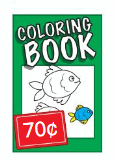
![]()
Answer:
I have 67 cents.
No, I do not have enough money to buy the coloring book.
Explanation:
1 dime =10 cents
so, 5 dimes = 5 x 10= 50 cents
1 nickel = 5 cents
So, 3 nickels = 3 x 5 = 15 cents
2 penny =2 cents
Total amount is 50+15+2 =67 cents
The coloring book costs 70 cents
So, I do not have enough money to buy the book.
Question 8.
You have 4 dimes, 1 nickel, and 3 pennies. How many more cents do you need to buy the whistle? Draw and label the coins you need.
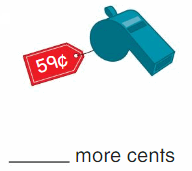
Answer:
I have 48 cents.
No , I do not have enough money to buy the whistle.
Explanation:
1 dime =10 cents
so, 4 dimes =4 x 10= 40 cents
1 nickel = 5 cents
3 pennies =3 cents
Total amount is 40+5+3 =48 cents
The whistle costs 59 cents so, I do not have enough money to buy the whistle.
Question 9.
DIG DEEPER!
You have 3 quarters, 2 nickels, and 3 pennies. Your friend has 1 quarter and 5 dimes. Who has more money? How much more?
![]()
Answer:
I have 13 cents money more than my friend .
Explanation:
My money :
1 quarter = 25 cents
So 3 quarters = 3 x 25 = 75 cents
1 nickel = 5 cents
So 2 nickel = 2 x 5 = 10 cents
3 pennies = 3 cents
Total amount: 75+10+3 = 88 cents
So, I have a total of 88 cents .
Friends money:
1 quarter= 25 cents
1 dime = 10 cents
So 5 dimes = 5 x 10 = 50 cents
Total amount = 25 +50= 75 cents
Friends money total is 75 cents
Now, the difference between my money and my friends money is
88 cents – 75 cents = 13 cents
That means, I have 13 cents more than my friend.
Find Total Values of Coins Homework & Practice 14.1
Count on to find the total value.
Question 1.

Answer:
65 cents
Explanation:
1 quarter = 25 cents
1 dime = 10 cents
Which means , 4 x 10 = 40 cents
Total : 25 + 40 = 65 cents
Therefore, the total value of coins is 65 cents.
Question 2.

Answer:
38 cents
Explanation:
1 dime = 10 cents
Which means , 3 dime = 3 x 10 = 30 cents
1 nickel = 5 cents
and 3 cents
Total : 30+ 5 + 3 = 38 cents
Question 3.

Answer:
72 cents
Explanation:
1 quarter = 25 cents
1 dime = 10 cents
Which means, 4 x 10 = 40 cents
1 nickel = 5 cents
and 2 cents
Total : 25 + 40+ 5 + 2 =72 cents
Question 4.
DIG DEEPER!
You had 52¢. You lost a coin. Now you have the 5 coins shown. What coin did you lose?

Answer:
1 quarter = 25 cents
1 dime = 10 cents
1 nickel = 5 cents
and 2 cents
Total : 25+10+5+2 = 42 cents
Total amount i have is 52 cents
Now , 52 – 42 = 10
1 dime = 10 cents
So , I lost 1 dime.
Question 5.
Precision
Circle coins to show 80¢.
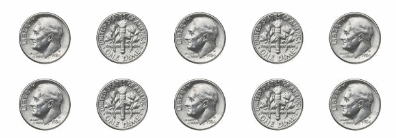
Answer:
1 dime = 10 cents
80 cents = 8 dimes

Question 6.
Modeling Real Life
You have 3 quarters, 1 nickel, and 4 pennies. How many cents do you have? Do you have enough money to buy the boomerang?

Answer:
No, I do not have enough money to buy the boomerang.
Explanation:
The cost of boomerang is 94 cents
1 quarter = 25 cents
3 x 25 =75 cents
1 nickel =5 cents
4 pennies = 4 cents
Total amount : 75+5+4 =84
I have 84 cents .
No, I do not have enough money to buy the boomerang
Question 7.
Modeling Real Life
You have 1 quarter, 3 dimes, and 1 nickel. How many more cents do you need to buy the toy bird? Draw the coins you need.
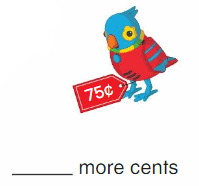
Answer:
The cost of bird is 75 cents.
Explanation:
1 quarter = 25 cents.
1 dime = 10 cents,
3 dimes = 3 x 10 = 30 cents
1 nickel = 5 cents
Total amount : 25 +30+ 5 =60 cents
Now,
75- 60 = 15cents
I need 15 more cents to buy the toy bird .
Review & Refresh
Compare.
Question 8.
![]()
Answer:
324 > 317
327 is greater 317
Question 9.
![]()
Answer:
426 > 206
426 is greater than 206
Question 10.
![]()
Answer:
546 < 564
564 is greater than 546
Question 11.
![]()
Answer:
931 > 842
931 is greater than 846
Lesson 14.2 Order to Find Total Values of Coins
Explore and Grow
Order your coins from the greatest value to the least value. Draw and label each coin with its value. What is the total value of all the coins?

Explain how ordering the coins helped you find the total.
_____________________________________
_____________________________________
_____________________________________
_____________________________________
Answer:
1 quarter = 25 cents
1 dime = 10 cents
1 nickel = 5 cents
and 1 penny = 1 cent
Total value of coins :
25+10+5+1=41 cents
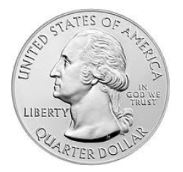 >
>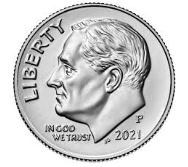 >
>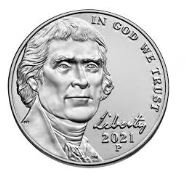 >
>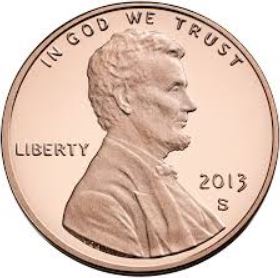
Show and Grow
Draw and label the coins from the greatest value to the least value. Then find the total value.
Question 1.

Answer:
45 cents
Explanation:
1 quarter = 25 cents
1 dime = 10 cents
1 nickel = 5 cents
Which means , 2 x 5 = 10 cents
Total value :
25 +10 + 10 = 45 cents
 >
>  >
>
Quarter > Dime > Nickel
Question 2.

Answer:
1 quarter = 25 cents
which means, 2quarters = 2 x 25= 50 cents
1 dime = 10 cents
1 nickel = 5 cents
and 1 penny = 1 cents
Total : 50 +10+5+1 = 66 cents
Therefore total value of coins is 66 cents .
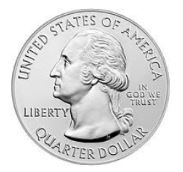 >
>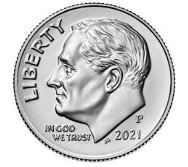 >
>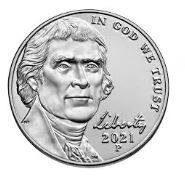 >
>
Question 3.

Answer: 31 cents
Explanation:
1 dime = 10 cents
which means , 2 dimes = 2 x 10 = 20 cents
1 nickel = 5 cents
which means , 2 nickel = 2 x5 = 10 cents
and 1 penny = 1 cent
Total : 20 +10 +1 = 31
Therefore, total value of coins is 31 cents
 >
> >
> 
Apply and Grow: Practice
Draw and label the coins from the greatest value to the least value. Then find the total value.
Question 4.

Answer:
41 cents
Explanation :
1 quarter = 25 cents
1 dime = 10 cents
1 nickel = 5 cents
and 1 penny = 1 cent
Total value = 25 +10 +5 +1 =41
Therefore total value of coins is 41 cents
 >
> >
> >
>
Question 5.

Answer:
27 cents
Explanation :
1 dime = 10 cents
which means , 2 dimes = 2 x 10 = 20 cents
1 nickel = 5 cents
and 2 pennies = 2 cents
total : 20 +5 +2= 27
Therefore total value of coins is 27 cents .
 >
> >
>
Question 6.

Answer:
85 cents
Explanation :
1 quarter = 25 cents
Which means, 2 quarter = 2 x25 = 50 cents
1 dime = 10 cents
Which means, 3 dimes = 3 x 10 = 30 cents
And 1 nickel = 5 cents
Total :
50 +30 +5 = 85 cents
Therefore total value of coins is 85 cents.
 >
> >
>
Question 7.
Reasoning
You have a dime, a nickel, and one other coin. The total value is 40¢. What is your third coin?

Answer:
The total value of 3 coins is 40 cents
1 dime = 10 cents
1 nickel = 5 cents
10 cents + 5 cents = 15 cents
Now , 40 cents – 15 cents = 25 cents
So the other coin is quarter
1 quarter = 25 cents
Therefore, 25 +10+ 5 = 40 cents.
Think and Grow: Modeling Real Life
You have 3 nickels and 4 pennies in one pocket. You have 2 dimes and 2 quarters in your other pocket. How much money do you have in all? Do you have enough money to buy the car?


Answer:
The cost of car is 9 cents .
The amount i have in one pocket is 3 nickels and 4 pennies
1 nickel = 5 cents
which means , 3 nickels = 3 x 5 = 15 cents
4 pennies = 4 cents
Total = 15 cents + 4 cents = 19 cents
The amount i have in another pocket is 2 dimes , 2 quarters
1 dime = 10 cents
in which , 2 dimes = 2 x 10 = 20 cents
1 quarter = 25 cents
2 quarters = 2 x 25 = 50 cents
Total : 20 cents + 50 cents = 70 cents
Total amount in both the pockets is 70 cents + 19 cents =89 cents
No, I do not have enough money to buy the car.
Show and Grow
Question 8.
You have 30¢. You find 2 nickels, 1 dime, and 3 pennies in your room. How much money do you have now? Do you have enough money to buy the yo-yo?

![]()
Answer:
I have 30 cents
Amount I found in my room =
1 nickel = 5 cents ,
2 nickel x 5 = 10 cents.
1 dime =10 cents.
3 pennies = 3 cents.
Total : 10 +10 + 3
=23 cents
Now, total amount i have is
30 cents +23 cents = 53 cents
The cost of yo-yo is 50 cent
So , now I have enough money to buy the yo- yo
Question 9.
You have 1 nickel, 1 quarter, and 4 dimes. How many more cents do you need to buy the stuffed animal? Draw and label the coin you need.
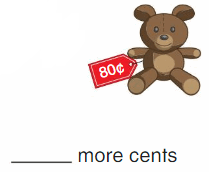
Answer:
1 nickel = 5 cents
1 quarter= 25 cents
1 dime =10 cents
Which means 4 dimes = 4 x 10=40 cents
Total amount = 5+25+40 =70 cents
But the cost of stuffed animal is 80 cents
So , I do not have enough cents to buy the stuffed animal.
I need 10 more cents to buy the stuffed animal.
Question 10.
DIG DEEPER!
You have 65¢. You give your friend a dime. You have 3 coins left. Draw and label the coins you have left.
Answer:
Given that,
I have 65 cents
The amount I gave to my friend is 1 dime
1 dime = 10 cents
Now,
65 cents – 10 cents = 55 cents
55 cents can be shown in 3 coins as
2 quarters and 1 nickel



Order to Find Total Values of Coins Homework & Practice 14.2
Draw and label the coins from the greatest value to the least value. Then find the total value.
Question 1.

Answer: 35 cents
Explanation :
1 dime = 10 cents
which means, 2 dimes = 2 x 10 = 20 cents
and 1 nickel = 5 cents
which means, 3 nickels = 3 x 5 = 15 cents
Total: 20 +15 = 35 cents
Therefore total value of coins is 35 cents.
 >
>
Question 2.

Answer: 63 cents
Explanation:
1 quarter = 25 cents
Which means , 2 quarters = 2 x 25 = 50 cents
1 dime = 10 cents
and 3 pennies = 3 cents
Total : 50 +10+3 = 63 cents
 >
> >
>
Question 3.

Answer: 46 cents
Explanation :
1 quarter = 25 cents
1 dime = 10 cents
1 nickel = 5 cents
Which means , 2 nickel = 2 x 5 = 10 cents
and 1 penny = 1 cents
Total :
25 +10 +5 +5+1 = 46 cents
 >
> >
> >
>
Question 4.
Open-Ended
Draw and label four coins that have a total value of 40¢
Answer: 40 cents can be written as 4 dimes
1 dime = 10 cents
Which means , 4 x 10 = 40 cents.




Question 5.
Modeling Real Life
You have 46¢. You find 4 pennies and 1 nickel in your room. How much money do you have now? Do you have enough money to buy the app?

![]()
Answer:
I have 46 Cents
Explanation:
The amount I found is
4 pennies = 4 cents
1 nickel = 5 cents
Total : 5 + 4 = 9 cents
Now,
Total amount I have is 46 cents +9 cents = 55 cents
The cost of app is 50 cents
yes , I have enough money to buy the app.
Question 7.
DIG DEEPER!
You have some nickels and dimes. You have 1 more nickel than dimes. The total value of your coins is 50¢. How many nickels and dimes do you have?
![]()
Answer:
I have 4 nickels and 3 dimes.
Explanation:
1 nickel =5 cents
That means, 4 nickels= 4 x 5 = 20 cents
1 dime = 10 cents
That means , 3 dimes = 3 x 10 = 30
Total: 20 + 30 = 50 cents
So, I have 4 nickels and 3 dimes.
Review & Refresh
Question 8.
Which fruit is the least favorite?
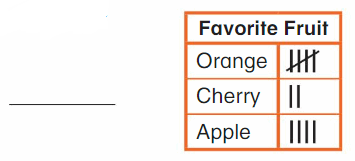
Answer:
Cherry is the least favorite.
Explanation :
In the given table ,
Total lines for orange fruit are 5
Total lines for cherry fruit are 2
Total lines for apple fruit are 4
On comparing them , 2 is smaller than 4 and 5
so, Cherry is the least favorite.
Lesson 14.3 Show Money Amounts in Different Ways
Explore and Grow
Use your coins to show 25 cents in two different ways. Draw and label the coins.
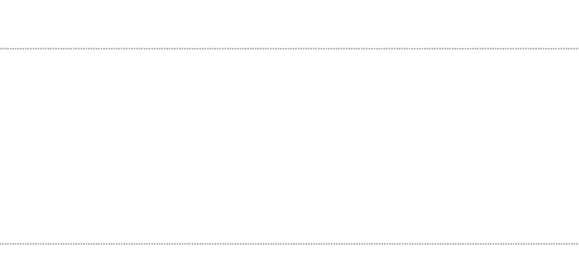
Answer :
25 cents can be written as
1 quarter
1 quarter = 25 cents

Another way :
25 cents can be written as
2 dime , 1 nickel
1 dime = 10 cents
Which means , 2 dime = 2 x 10= 20
1 nickel = 5 cents.



Did everyone in your class use the same coins?
_____________________________________
_____________________________________
_____________________________________
_____________________________________
Answer:
No, everyone used different coins to make a total value of 25 cents
For example, my friend used 1 dime, 3 nickels
1 dime = 10 cents
1 nickel = 5 cents
Which means , 3 x 5 = 15 cents
Total : 10 + 15 = 25 cents
Show and Grow
Show the amount in two different ways.
Question 1.

Answer:
45 cents can be written as
4 dime + 1 nickel
Which means one dime = 10 cents
4 dime = 4 x 10 = 40
1 nickel = 5 cents
Total: 40+5 = 45
Another way: 1 quarter +2 dime
Which means , 1 quarter =25 cents
1 dime= 10 cents
2 dime = 2 x 10 = 20
Total=: 25+20= 45
Therefore, 45 can be written as 4 dime 1 nickel and 1 quarter 2 dime
Question 2.

Answer:
27 cents can be written as
2 dime +1 nickel+2 penny
Which means , 1 dime = 10 cents
2 dime = 2 x 10= 20 cents
1 nickel = 5 cents2 penny = 2 cents
Total: 20+5+ 2= 27 cents
Another way:
1 quarter+2 pennies
Which means , 1 quarter = 25 cents
2 penny = 2 cents
Total= 25 + 2 = 27 cents
Therefore 27 cents can be written as 2 dime +1 nickel+2 penny and 1 quarter +2 pennies
Question 3.
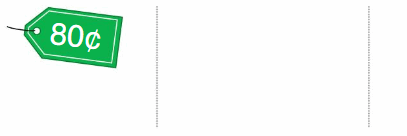
Answer:
80 cents can be written as
8 dimes
Which means 1 dime = 10 cents
So 8 dimes = 80 cents
Another way:
3 quarter + 1 nickel
Which means , 1 quarter = 25 cents
3 quarters = 3 x 25 = 75 cents
1 nickel = 5 cents
Total : 75 + 5 = 80 cents
Therefore, 80 cents can e written as 8 dimes and 3quarter and 1 nickel .
Apply and Grow: Practice
Show the amount in two different ways.
Question 4.

Answer:
23 cents can be written as
2 dime 3 pennies
Which means , 1 dime = 10 cents
2 dimes =2 x 10 = 20 cents
3 pennies = 3 cents
Total : 20 + 3 = 23 cents
Another way:
4 nickel ,3 pennies
Which means, 1 nickel = 5 cents
4 nickel = 4 x 5 =20 cents
3 pennies = 3 cents
Total= 20 + 3 =23 cents
Therefore 23 cents can be written as 2 dimes + 3 pennies and 4 nickel + 3 pennies
Question 5.

Answer:
49 cents can be written as
1 quarter ,2 dime ,4 pennies
Which means , 1 quarter = 25 cents
1 dime = 10 cents
So,2 dime = 2 x 10 = 20 cents
4 pennies = 4 cents
Total : 25 +20+4 =49 cents
Another way :
49 Pennies
1 penny = 1 cent
49 pennies = 49 cents
Therefore, 49cents can be written as 1 Quarter 2 dime 4 pennies and 49 pennies.
Question 6.

Answer:
75 cents can be written as
3 quarters
1 quarter = 25 cents
Which means , 3 quarters = 3 x 25 = 75
Another way:
1 quarter, 5 dimes
1 quarter = 25 cents
1 dime = 10 cents
Which means , 5 dimes = 5 x 10 = 50 cents
Total : 25 + 50 = 75 cents
Therefore , 75 cents can be written as 3 quarters and 1 quarter , 5 dimes
Question 7.
Structure
You have 55¢. You have no quarters. Draw to show what coins you might have.
Answer:
55 cents be written as 5 dimes , 1 nickel .
1 dime = 10 cents
Which means , 5 dimes = 5 x 10 = 50 cents
1 nickel = 5 cents
Total : 50 cents + 5 cents = 55 cents.






Question 8.
YOU BE THE TEACHER
Newton says he drew the fewest number of coins to show 66¢. Is he correct? Explain.

Answer :
No, he is wrong
Newton used 6 coins to show 66 cents .
66 cents can also be shown as
2 quarters , 1 dime , 1 nickel and 1 cents
Total number of coins is 5
1 quarter = 25 cents
Which means , 2 quarters = 2 x 25 = 50 cents
1 dime = 10 cents
1 nickel = 5 cents
and cent
Total value of coins is 50+ 10 + 5 +1 = 66
Therefore ,66 cents can be shown in 5 coins .
so , Newton is wrong.
Think and Grow: Modeling Real Life
Newton has 2 dimes, 1 nickel, and 1 penny. Descartes uses the fewest number of coins to make the same amount. Draw and label their coins.
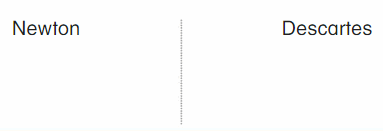
Answer:
Total number of coins newton have is 4
2 dimes , 1 nickel and 1 penny
1 dime = 10 cents
Which means, 2 dimes = 2 x 10 = 20 cents
1 nickel = 5 cents
and 1 penny = 1 cent
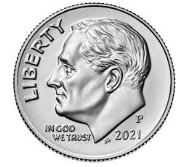

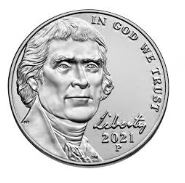
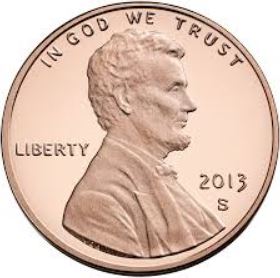
Total value of coins is
20 +5+1 = 26 cents.
Given that ,
Descartes uses fewest number of coins to make same amount
26 can also be shown with 2 coins
1 quarter = 25 cents
1 penny = 1 cents
Total value is
25 + 1 = 26 cents
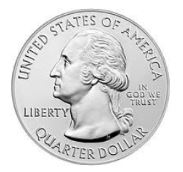

So, 26 cents can be shown with 2 coins
2 is less than 6 so , Descartes uses few coins than Newton to show the same amount.
Show and Grow
Question 9.
Newton has 3 dimes and 2 pennies. Descartes uses the fewest number of coins to make the same amount. Draw and label their coins.

Answer:
Total number of coins newton have is 5
3 dimes , 2 pennies
1 dime = 10 cents
Which means , 3 dimes = 3 x 10 = 30 cents
2 pennies = 2 cents.
Total value of coins is
30 + 2 = 32 cents





Given that,
Descartes used the fewest number of coins to make the same amount
32 cents can be shown in 4 coins
1 quarter, 1 dime and 2 pennies
1 quarter = 25 cents
1 dime = 10 cents
and 2 pennies = 2 cents
Total : 25 + 10 + 2 = 37 cents




So, 37 cents can be shown in 4 coins
4 is less than 5.
Descartes used few coins than newton to show the same amount
Question 10.
You use fewer than 5 coins to buy the pack of gum. Draw and label coins to show how you pay.

Answer:
The cost of gum is 70 cents
70 cents can be shown in 4 coins as
2 quarters , 2 dime
1 quarter = 25 cents
Which means , 2 x 25 = 50 cents
1 dime = 10 cents
Which means , 2 x 10 = 20 cents
Total amount = 50 + 20 = 70




Question 11.
DIG DEEPER!
You have 2 quarters. Newton and Descartes each have 5 coins and the same amount of money as you. Their coins are different. Draw and label their coins.

Answer:
1 quarter = 25 cents
Which means, 2 quarters= 2 x 25 = 50 cents
50 cents can be shown in 5 coins as 5 dime
1 dime = 10 cents
Which means 50 cents = 5 dimes





Show Money Amounts in Different Ways Homework & Practice 14.3
Show money amounts in different ways.
Question 1.
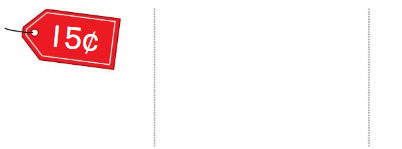
Answer:
15 cents can be written as:
1 dime +1 Nickel
which means 1 dime = 1o cents
1 nickel =5 cents
10+5 = 15 cents
Another way:
15 cents can also be written as:
1 dime +5 pennies
1 dime =10 cents
5 pennies = 5 cents
Total: 10 +5 = 15 cents
So, 15 cents can be written as 1 dime 1 nickel and 1 dime 5 pennies
Question 2.
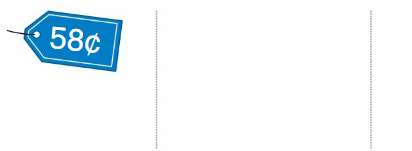
Answer:
58 cents can be written as
2 quarter 8 pennies
1 quarter = 25 cents
Which means 2 quarters = 2 x 25 = 50 cents
8 pennies = 8 cents
Total : 50 + 8 = 58 cents
Another way :
5 dime 1 nickel 3 pennies
Which means,
1 dime = 10 cents
=5 dime = 5 x 10 = 50cents
1 nickel = 5 cents
1 pennies = 3 cents
Total : 50+ 5+3= 58
So, 58 cents can be written as 2 quarter 8 pennies and 5 dime 1 nickel 3 pennies.
Question 3.

Answer:
90 cents can be written as
3 quarters 1 nickel 1 dime
Which means,
1quarter =25 cents
3 quarters = 3 x 25 = 75 cents
1 nickel =5 cents
1 dime = 10 cents
Total : 75+5+10= 90 cents
Another way :
9 dimes
1dime = 10 cents
9 dimes = 9 x 10 = 90 cents .
So , 90 cents can be written as 3 quarters1 dime 1 nickel and 9 dimes.
Question 4.
Reasoning
Draw to show 60¢ with only 3 coins.
Answer:
60 cents can be drawn in 3 coins as
2 quarters and 1 dime
1 quarter = 25 cents
Which means , 2 x 25 = 50 cents
1 dime = 10 cents
Total : 50 + 10 = 60.



Question 5.
Structure
Draw to show 42¢ without using dimes.
Answer:
42 cents can be drawn as
1 quarter , 3 nickels and 2 pennies
1 quarter = 25 cents
1 nickel = 5 cents
Which means 3 x 5 = 15 cents
2 pennies = 2 cents
Total : 25 +15 + 2 = 42 cents






Question 6.
Modeling Real Life
Newton has 6 dimes and 1 nickel. Descartes uses the fewest number of coins to make the same amount. Draw and label their coins.

Answer :
6 dimes and 1 nickel
Total number of coins is 7
1 dime = 10 cents
Which means, 6 dimes = 6 x 10 = 60 cents
1 nickel = 5 cents
Total : 60 +5 = 65 cents
65 cents can be shown in fewest number of coins as
2 quarters , 1 dime and 1 nickel
Total number of coins is 4




Question 7.
Modeling Real Life
You use fewer than 5 coins to buy the pen. Draw and label coins to show how you pay.
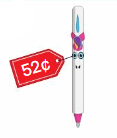
Answer:
The cost of pen is 52 cents
52 cents be shown in fewer than 5 coins as
2 quarter and 2 pennies
1 quarter = 25 cents
Which means, 2 quarters = 2 x 25 = 50 cents
and 2 pennies = 2 cents
Total 50 +2 = 52 cents.




Review & Refresh
Question 8.
A green scarf is 50 inches long. An orange scarf is 40 inches long. A red scarf is 38 inches long. How much longer is the green scarf than the red scarf?

Answer:
22 inches
Explanation:
The length of green scarf is 50 inches
The length of red scarf is 38 inches
Now ,
50 inches – 38 inches = 22 inches
Therefore , Green scarf is 22 inches longer than red scarf.
Lesson 14.4 Make One Dollar
Explore and Grow
Newton has 4 coins. The total value is 100¢. Draw and label his coins
Answer:
Given ,
The total value of money is 100 cents
100 cents can be shown in 4 coins as 4 quarters
1 quarter = 25 cents
Which means 4 quarters = 4 x 25 = 100 cents
So, Newton has 4 quarters




![]()
Descartes has 10 coins. The total value is 100¢. Draw and label his coins.
Answer:
Given ,
Total value of money is 100 cents
100 cents be shown in 10 coins as 10 dimes
1 dime = 10 cents
Which means , 10 dimes = 10 x 10 = 100 cents
So, Descartes have 10 dimes .

Show and Grow
Draw coins to make $1. How many cents do you need?
Question 1.
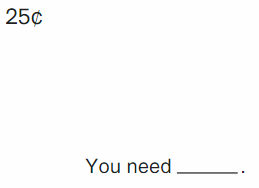
Answer:
$1 = 100 cents
So, 100 cents – 25 cents = 75 cents
I need 75 cents to make $1.
75 Cents can e shown as 3 quarters
1 quarter = 25 cents
3 quarters = 3 x 25 = 7 cents



Question 2.
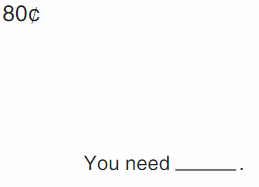
Answer:
$1 = 100 cents
So, 100 cents – 80 cents = 20 cents
I need 20 cents to make $1.
20 cents can be shown as 2 dimes
1 dime = 10 cents
2 dimes = 2 x 10 = 20 cents


Apply and Grow: Practice
Draw coins to make $1. How many cents do you need?
Question 3.
35¢

Answer: $1 = 100 cents
So, 100 cents – 35 cents = 65 cents
I need 65 cents to make $1.
65 cents can be shown as
2 quarters , 1 dime and 1 nickel
1 quarter = 25 cents
Which means , 2 quarters = 2 x 25 = 50 cents
1 dime = 10 cents
and 1 nickel = 5 cents
Total : 50 +10 +5 = 65 cents




Question 4.
72¢

Answer:
$1 = 100 cents
So, 100 cents – 72 cents = 28 cents
I need 28 cents to make $1.
28 cents can be shown as
1 quarter , 3 pennies
1 quarter = 25 cents and
3 pennies = 3 cents
Total : 25 +3 = 28 cents




Question 5.
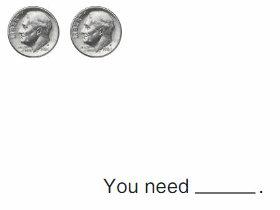
Answer:
$1 = 100 cents
1 dime = 10 cents
so 2 dimes = 2 x 10 = 20 cents
so, 100 cents – 20 cents = 80 cents
I need 20 cents to make $1.
20 cents can be shown as 2 dimes
1 dime = 10 cents
Which means , 2 dimes = 2 x 10 = 20 cents


Question 6.
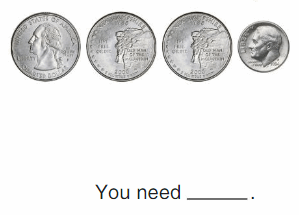
Answer: $1 = 100 cents
1 quarter = 25 cents
Which means , 3 x 25 = 75 cents
1 dime = 10 cents
Total : 75 + 10 = 85 cents
Now, 100 – 85 = 15 cents
So, I need 15 cents to make $1.
15 cents can be shown as
1 dime and 1 nickel
1 dime = 10 cents
1 nickel = 5 cents
Total : 10 +5 = 15 cents


Question 7.
Number Sense
Circle coins to make $1.
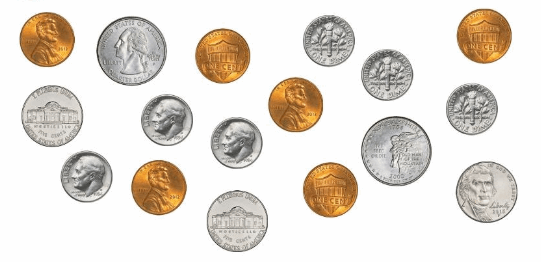
Answer:
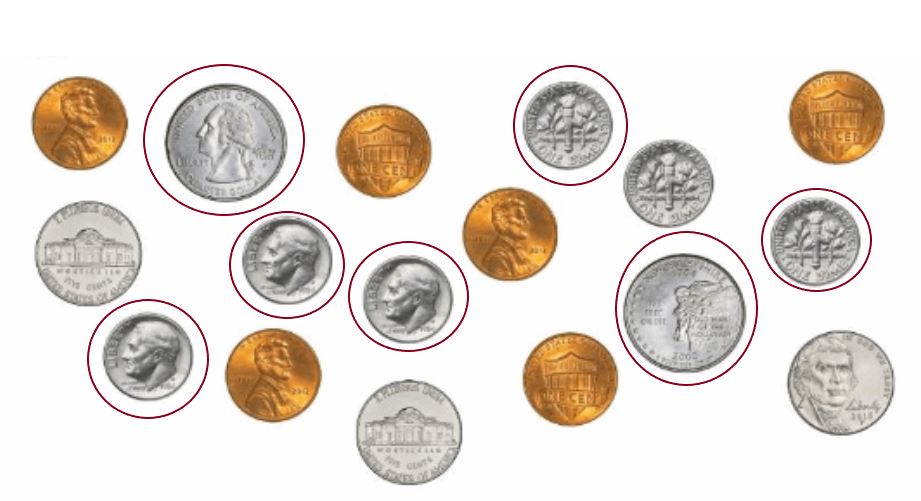
Explanation:
$1 is equals to 100 cents
1 quarter = 25 cents
Which means
2 quarters = 2x 25 = 50 cents
1 dime = 10 cents
5 dimes = 5 x 10 = 50 cents
Total : 50 +50 = 100 cents
So, 2 quarters and 5 dimes make $1.
Think and Grow: Modeling Real Life
You have 1 quarter, 3 pennies, and 1 dime in one pocket. You have 2 pennies, 2 nickels, and 4 dimes in your other pocket. How many more cents do you need to make $1?

Answer:
The amount i have in one pocket is
1 quarter =25 cents
3 pennies = 3 cents
and 1 dime = 10 cents
Total : 25 +10 +3 = 38 cents
The amount I have in another pocket :
2 pennies = 2 cents
1 nickel = 5 cents
which means, 2 nickels = 2 x5 = 10 cents
1 dime = 10 cents
Which means, 4 dimes = 4 x 10 = 40 cents .
Total : 2 + 10 +40 =52 cents
Now , the total amount i have in both pockets is
38+52 = 90 cents
We know that $1 is equal to 100 cents
100 – 90 = 10
10 cents can be shown as 1 dime
 .
.
Show and Grow
Question 8.
You have 2 dimes and 1 nickel in your desk. You have a quarter and 10 pennies in your backpack. How many more cents do you need to make $1?
![]()
Answer:
Total amount I have in my desk is
2 dimes and 1 nickel
1 dime = 10 cents
Which means, 2 dime =2 x 10 = 20 cents
1 nickel = 5 cents
Total = 20 +5 = 25 cents
Total amount I have in my pocket is
a quarter and 10 pennies
1 quarter = 25 cents
and 10 pennies = 10 cents
Total : 25 +10 = 35 cents
Total amount I have is
The amount in my desk + the amount in my pocket
Which means, 25 cents +35 cents
=60 cents
We know that ,
$1 is equal to 100 cents
100 cents – 60 cents
= 40 cents.
So, I need 40 cents more to make $1.
Question 9.
A notebook costs $1. You have 5 dimes and 4 pennies. How much more money do you need to buy the notebook?

Answer:
1 dime = 10 cents
Which means 5 dimes = 5 x 10 = 50 cents
and 4 pennies = 4 cents
Total : 50 cents +4 cents = 54 cents
we know that,
$1 is equal to 100 cents
Now , 100 – 54 = 46 cents
So ,I need 46 cents more to buy the book.
Question 10.
DIG DEEPER!
You have a $1 bill. You have 33 more cents than your friend. How much money does your friend have?
![]()
Answer:
I have $1 bill
Given that I have 33 cents more than my friend
We know that ,$1 is equal to 100 cents
Now,
100 cents – 33 cents = 67 cents
So , my friend have 67 cents.
Make One Dollar Homework & Practice 14.4
Draw coins to make $1. How many cents do you need?
Question 1.
54¢

Answer: $1 = 100 cents
so, 100 cents – 54 cents = 46 cents
I need 46 cents to make $1.
46 cents can be shown as
1 quarter , 2 dime and 1 penny
1 quarter = 25 cents
1 dime = 10 cents
Which means, 2 dimes = 2 x 10 = 20 cents
and 1 penny = 1 cent
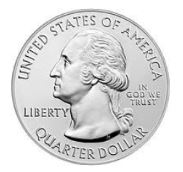
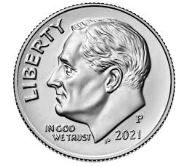


Question 2.
38¢
![]()
Answer:
$1 = 100 cents
So, 100 cents – 38 cents = 62 cents
I need 62 cents to make $1.
62 cents can be shown as
2 quarters, 1 dime and 2 pennies.
1 quarter = 25 cents
Which means , 2 quarters = 2 x 25 = 50
1 dime= 10 cents
2 pennies = 2 cents





Question 3.
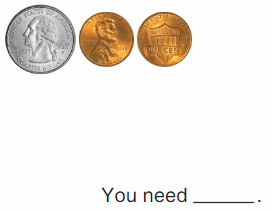
Answer:
$1 =100 cents
Given coins are 1 quarter and 2 pennies
1 quarter = 25 cents
and 2 pennies = 2cents
Total value : 25 +2 = 27
So, 100 – 27 =73
Therefore , I need 73 cents to make $1
73 cents can be shown as
2 quarters , 2 dime and 3 pennies
1 quarter = 25 cents
Which means 2 quarters = 2 x 25 = 50 cents
1 dime = 10 cents
Which means , 2 dimes = 2 x 10 = 20 cents
and 3 pennies = 3 cents
Total : 50 +20 +3 = 73.







Question 4.
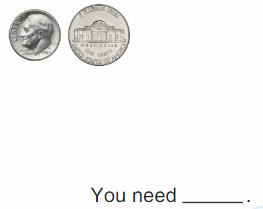
Answer:
$1 = 100 cents
Given coins are 1 dime and 1 nickel
1 dime = 10 cents
1 nickel = 5 cents
Total : 10 +5 = 15 cents
Now , 100 cents – 15 cents =85 cents
So , I need 85 cents to make $1.
85 cents can be written as
3 quarters , 1 dime
1 quarter = 25 cents
Which means , 3 quarters = 3 x 25 = 75 cents
1 dime = 10 cents
Total : 75 +10 = 85 cents




Question 5.
Structure
Show $1 using only nickels and dimes.
Answer:
1 dime = 10 cents and
1 nickel = 5 cents
$1 is equals to 100 cents
100 cents can be shown as 8 dimes 4 nickels
8dimes = 8 x 10 = 80
4 nickels = 4 x 5 = 20
Total value = 100 cents












Question 6.
Structure
How many nickels make $1?
![]()
Answer :
20 nickels
1 nickel = 5 cents
Which means ,20 nickels =
20 x 5 = 100
100 cents =$1
So 20 nickels make $1.
Question 7.
Modeling Real Life
You have 1 dime and 4 nickels in a jar. You have 1 quarter and 3 pennies in your pocket. How many more cents do you need to make $1?
![]()
Answer:
The amount I have in jar is
1 dime = 10 cents
and 1 nickel = 5 cents
Which means , 4 nickels = 4 x 5 = 20 cents
Total : 10 + 20 = 30 cents
The amount i found in my pocket is
1 quarter = 25 cents
and 3 pennies = 3 cents
Total : 25+ 3 = 28 cents
Now , the total amount i have is
Amount in jar +amount in my pocket
= 30 +28 = 58cents
We know that, $1 is equal to 100 cents
100 – 58 = 42 cents
So, I need 42 cents more to make $1.
Question 8.
Modeling Real Life
A snack costs $1. You have 2 quarters and 2 dimes. How much more money do you need to buy the snack?
Answer:
The cost of snack is $1.
1 quarter = 25 cents
2 quarters = 2x 25= 50 cents
1 dimes = 10 cents
2 dimes= 2 x 10 = 20 cents
Total : 50 +20= 70 cents
$1 = 100 cents
100 – 70 = 30 cents
So , I need 30 cents more to buy the snack.
Review & Refresh
Question 9.
100 – 54 = ____
Answer : 46

By regrouping, 0 in units place becomes 10 and the 0 in tens place becomes 9 after the second regrouping.
Question 10.
200 – 134 = ____
Answer: 64

By regrouping, 0 in units place becomes 10 and the 0 in tens place becomes 9 after the second regrouping.
Lesson 14.5 Make Change from One Dollar
Explore and Grow
Model the story.
Newton buys a bag of fish crackers for 45¢. He pays with a $1 bill. What is his change?

![]()
Explain how you solved.
_______________________________
_______________________________
_______________________________
_______________________________
Answer: 55 cents
Explanation :
$1 is equals to 100 cents
The cost of fire crackers is 45 cents
Now his change is
$1 bill – cost of fire crackers
100 cents -45 cents
=55 cents
So, Newtons change is 55 cents.
Show and Grow
You buy the item shown. You pay with a $1 bill. What is your change?
Question 1.
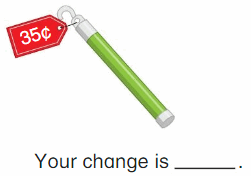
Answer:
65 Cents
Explanation:
$1 is equal to 100 cents
So, 100 cents – 35cents = 65
Therefore, 65 cents is the change.
Question 2.
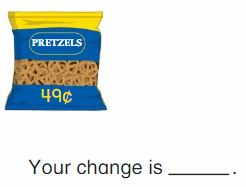
Answer: 51 Cents
Explanation:
$1 is equals to 100 cents
So, 100 cents – 49 cents = 51 cents
Therefore: 51 cents is the change.
Apply and Grow: Practice
You buy the item shown. You pay with a $1 bill. What is your change?
Question 3.
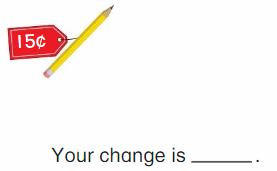
Answer: 85 Cents
Explanation:
$1 = 100 cents
So, 100 cents -15 cents =85 cents
Therefore 85 cents is the change.
Question 4.
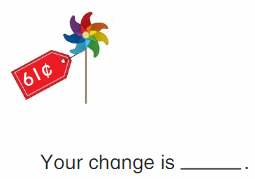
Answer: 39 Cents
Explanation:
$1 = 100 cents
So, 100 cents -61 cents =39 cents
Therefore 39 cents is the change.
Question 5.
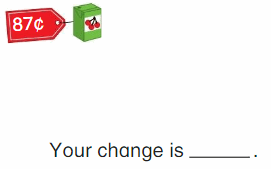
Answer: 13 Cents
Explanation:
$1 = 100 cents
So, 100 cents -87 cents =13 cents
Therefore ,13 cents is the change.
Question 6.
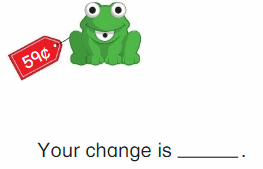
Answer: 41 Cents
Explanation:
$1 = 100 cents
So, 100 cents -59 cents =41 cents
Therefore ,41 cents is the change.
Question 7.
Reasoning
Newton buys a notebook for 34¢. Descartes buys one for 52¢. You buy one for 48¢. You each pay with $1. Who gets back the most amount of money? How do you know?
__________________
__________________
__________________
Answer:
Newton gets back the most amount of money.
Explanation:
$1 is equals to 100 cents
Given that ,
The cost of newtons book is 34 cents
So, 100 cents – 32 cents = 68 cents .
The cost of Descartes book is 52 cents.
So , 100 cents – 52 cents = 48 cents.
The cost of my book is 48cents .
So, 100 cents – 48 cents = 52 cents
Therefore, newton gets back the most amount of money.
Think and Grow: Modeling Real Life
You pay for some school supplies with $1. Your change is 17¢. How much money did you spend?
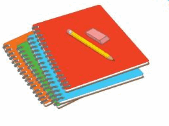

Answer: 83 Cents
Explanation:
$1 is equals to 100 cents
My change is 17 cents
Now , 100 cents – 17 cents =83 cents
So, the cost of school supplies is 83 cents.
Show and Grow
Question 8.
You pay for some erasers with $1. Your change is 38¢. How much money did you spend?

Answer: 62 Cents
Explanation:
$1 is equals to 100 cents
My change is 38 cents
Now , 100 cents – 38 cents =62 cents
So the cost of erasers is 62 cents.
Question 9.
You buy a toy ring. You pay with $1. You get back 1 quarter, 2 dimes, 1 nickel, and 1 penny. How much does the toy ring cost?
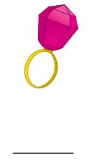
Answer: 59 Cents.
Explanation:
$1 is equals to 100 cents
My change is 1 quarter = 25 cents
1dime = 10 cents
Which means , 2 dimes = 2 x 10 = 20 cents
1 nickel = 5 cents
1 penny = 1 cent
Total = 25 +10 + 5 +1 =41 cents
100 cents – 41 cents = 59 cents
Therefore , the cost of toy ring is 59 cents.
Question 10.
You buy a banana for 25¢ and an orange for 45¢. You pay with $1. What is your change?

Answer: Change is 30 Cents.
Explanation:
The cost of banana is 25 cents and the cost of orange is 45 cents
Total cost : 25 cents + 45 cents = 70 cents
$1 is equals to 100 cents
Now, 100 – 70 = 30 cents
Therefore ,30 cents is the change.
Make Change from One Dollar Homework & Practice 14.5
You buy the item shown. You pay with a $1 bill. What is your change?
Question 1.
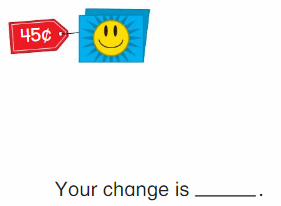
Answer: 55 Cents.
Explanation:
$1 = 100 cents
So, 100 cents -45 cents =55 cents
Therefore 55 cents is the change.
Question 2.
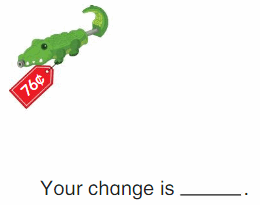
Answer: 24 Cents.
Explanation:
$1 = 100 cents
So, 100 cents -76 cents =24 cents
Therefore, 24 cents is the change.
Question 3.
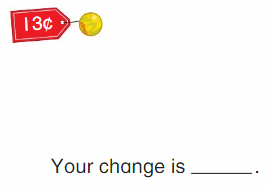
Answer: 87 Cents.
Explanation:
$1 = 100 cents
So, 100 cents -13 cents =87 cents
Therefore, 87 cents is the change.
Question 4.
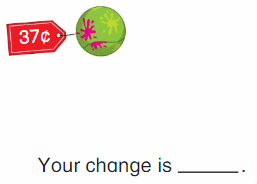
Answer: 63 Cents.
Explanation:
$1 = 100 cents
So, 100 cents -37 cents = 63 cents
Therefore, 63 cents is the change.
Question 5.
Reasoning
A puzzle costs 68¢. Newton pays for it with a $1 bill. Draw to show his change in two ways.
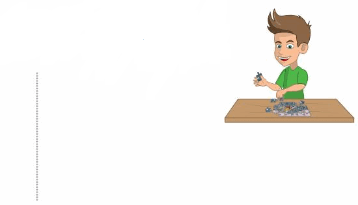
Answer: Change is 32 Cents.
Explanation:
$1 is equals to 100 cents
The cost of puzzle is 68 cents
Now, 100 – 68 = 32 cents
Therefore, 32 is the change.
32 cents can be written as 3 dime, 2 pennies





1 dime = 10 cents
3 dimes = 3 x 10 = 30 cents
2 pennies = 2 cents
Total : 30 + 2 = 32 cents
Another way ,
1 quarter 7 pennies








Which means, 1 quarter = 25 cents
7 pennies = 7 cents
Total: 25 + 7 = 32 cents
Therefore 32 cents can be written as 3 dime 2 pennies and 1 quarter 7 pennies.
Question 6.
Modeling Real Life
You buy a pencil sharpener. You give the cashier $1. You get back 2 quarters, 1 nickel, and 3 pennies. How much does the pencil sharpener cost?

Answer: 42 Cents.
Explanation:
$1 is equals to 100 cents
My change is 2 quarters 1 nickel 3 pennies
1 quarter = 25 cents
Which means , 2 quarters = 2 x 25 =50 cents
1 nickel = 5 cents
3 pennies = 3 pennies
Total: 50 +5+3=58 cents
Now,
100 – 58 = 42 cents
Therefore, the cost of the pencil sharpener is 42 cents .
Question 7.
Modeling Real Life
You buy an onion for 51¢ and a pepper for 22¢. You pay with a $1 bill. What is your change?
Answer: 27 Cents.
Explanation:
The cost of an onion is 51 cents and the cost of 22 cents
Total cost : 51 + 22 =73 cents
$1 is equals to 100 cents
100 cents – 73cents = 27 cents
Therefore, 27 cents is the change.
Review & Refresh
Question 8.
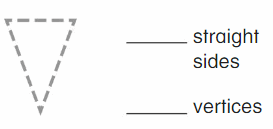
Answer: There are three straight sides and three vertices.
Question 9.
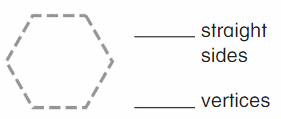
Answer: There are six straight sides and six vertices.
Lesson 14.6 Find Total Values of Bills
Explore and Grow
Model the story.
Descartes has three $5 bills and three $1 bills. How much money does he have in all?
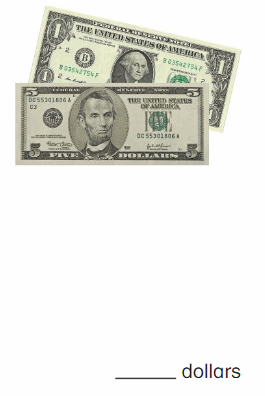
Answer: $18.
Explanation:
Given that ,
Descartes have Three $5 bills and three $1 bill
Three $5 bills = $5+$5+$5 = $15.
and three $1 bills = $3
Total amount =$15+$3= $18.
Show and Grow
Count on to find the total value.
Question 1.

Answer: $45.
Explanation:
Three $5 bills =$5+$5+$5 = $15
$10 and $20
Total value :
$15 +$10 +$20= $45
Therefore, total value = $45.
Question 2.

Answer: $32.
Explanation:
Two $1 bills = $2
Two $5 bills = $5+$5= $10
and two $10 = $10 +$10= $20
Total value = $2+$10+$20=$32
Therefore ,the total value is $32.
Apply and Grow: Practice
Count on to find the total value.
Question 3.

Answer: $16.
Explanation:
$10 ,$5 and $1
Total value :
$10 +$5 +$1 =$16
Question 4.

Answer: $36.
Explanation:
Total value of $20 , $10 ,$5 and $1
=$20 +$10 +$5 +$1 =$36 .
Question 5.

Answer: $75.
Explanation:
Total value of a $5 bill, $10 bill and three$20 bills is
$5+$10+$20+$20+$20= $75
Therefore the total value is $75.
Question 6.
Which One Doesn’t Belong?
Which group of bills does not belong with the other two?
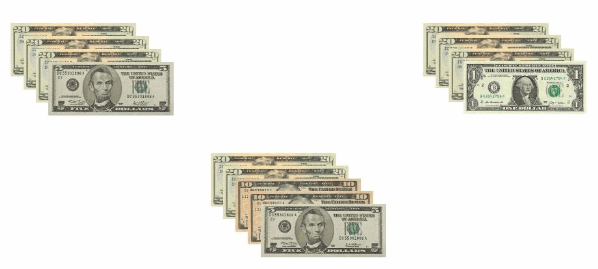
Answer:
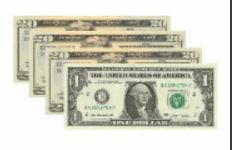
Explanation:
The total value of dollar bills is $61
But the remaining dollar sets total value is $65
So ,this set is different from the other two sets.
Think and Grow: Modeling Real Life
You buy some T-shirts for $39. Draw and label bills to show two different ways to pay for the T-shirts. One way should use the fewest number of bills.

Answer:
$39 can be shown as
A $20 bill ,a $10 bill ,a $5 bill and four $1 bills
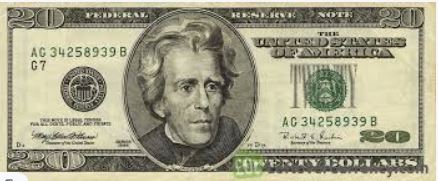
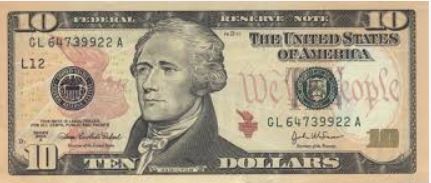
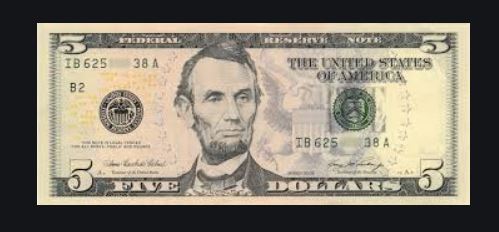
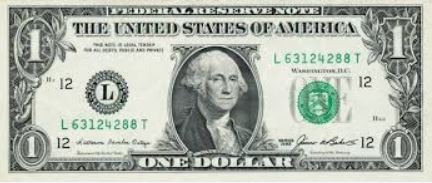



Another way:
$39 can be shown as
a $20 bill , three $5 bills and four $1 bills.








Show and Grow
Question 7.
You buy a pair of sneakers for $24. Draw and label bills to show two different ways to pay for the sneakers. One way should use the fewest number of bills.

Answer:
$24 can be shown as
a $20 bill and four $1 bill





$24 can also be shown as
A$20 bill and two $2 bills

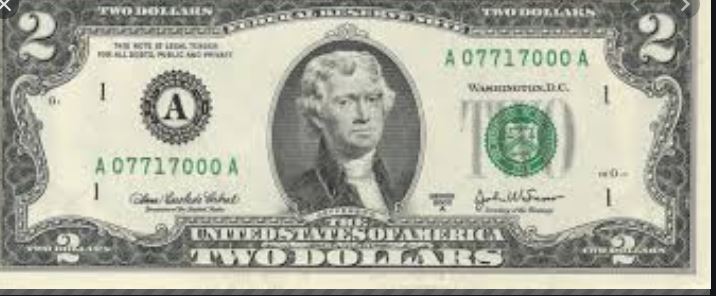

Question 8.
Newton has three $20 bills, one $10 bill, one $5 bill, and three $1 bills. Does he have enough money to buy a new dog house that costs $80? Explain.
Answer: No , he do not have enough money to buy a dog house
Explanation:
Three $20 bills = $20+$20+$20= $60
$10 , $5 and three $1
Total value :
$60 +$10 +$5+$1 = $76
But, the cost of dog house is $80
So, he do not have enough money to buy a dog house.
Question 9.
DIG DEEPER!
Explain why you would order a group of bills from the greatest value to the least value to find the total value.
_____________________________________
_____________________________________
Find Total Values of Bills Homework & Practice 14.6
Count on to find the total value.
Question 1.

Answer:
$10 +$ 1= $11
Therefore the total value is $11
Question 2.

Answer: $50
Explanation:
Two $10 bills = $10 +$10 = $20
Two $5 bills = $5+$5 = $10
Total value = $20+$20+$10 = $50
Question 3.

Answer: $91
Explanation:
Four $20 bills = $20 +$20 +$20 +$20 = $80
$10 and $ 1
Total value = $80 +$10 +$1 = $91.
Question 4.
YOU BE THE TEACHER
Newton says he drew the fewest number of bills to show $35. Is he correct? Explain.

Answer:
No , he is wrong.
Explanation:
$35 can be shown in few bills as
a $20 bill, a $10 and a $5 bill



Question 5.
Modeling Real Life
A pair of headphones costs $88. Draw and label bills to show two different ways to pay for the headphones. One way should use the fewest number of bills.

Answer:
The cost of head phones is $88 .
$ 88 can be shown as
four $20 bills, a $5 bill ,a $2 bill and a$1 bill
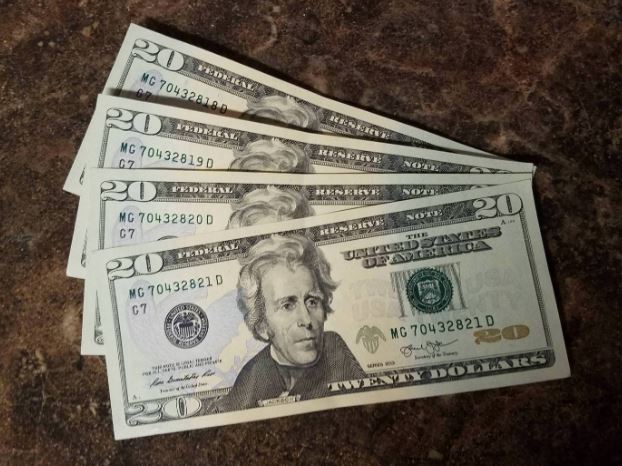
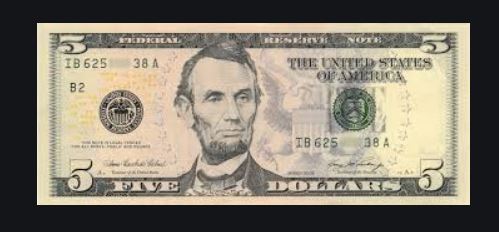
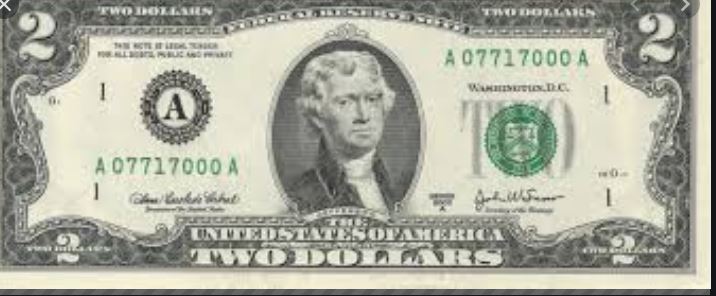
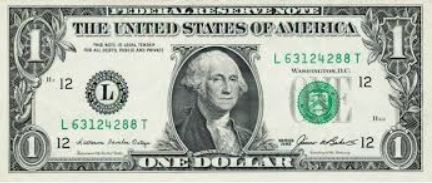
Question 6.
Modeling Real Life
Descartes has two $20 bills, three $10 bills, and four $1 bills. Does he have enough money to buy a scratching post that costs $62? Explain.
__________________________
__________________________
Answer:
Yes ,he have enough money to buy a scratching post
Explanation:
Descartes have
Two $20 bills
Which means , 2 x 20 = 40
Three $10 bills
Which means, 3 x 10 = 30
Four $ 1bills
Total : $40 +$30 +$4 =
$74
The cost of scratching post is $62
So ,Descartes have enough money to but the post.
Review & Refresh
Question 7.
A photo album has 3 rows of photos. There are 4 photos in each row. How many photos are there in all?

Answer: 12 Photos.
Explanation:
Given that,
A photo album has 3 rows of photos
and there are 4 photos in each row
Now, the total number of phone are
4 +4+4 = 12
So , there are 12 photos in all.
Lesson 14.7 Problem Solving: Money
Explore and Grow
Model the story.
You buy a book for 60¢. Your friend buys a book for 33¢. How much do you and your friend spend in all?


Explain how you solved.
_______________________________
_______________________________
_______________________________
_______________________________
Answer: 93 Cents.
Explanation:
The cost of my book is 60 cents and
The cost of my friends book is 33 cents
Total value of our money is
60 cents + 33 cents
= 93 cents.
Therefore, me and my friend spent 93 cents in all.
Show and Grow
Question 1.
Descartes has two $10 bills and two $5 bills. He has $21 more than Newton. How much money does Newton have?

Answer: $9
Explanation:
Total amount of Descartes is
Two $10 bills
Which means, 2 x $10 bills = $20
Two $5 bills
Which means , 2 x $5 = $10
Total value = $20 +$10 = $30
Descartes have $30
Given that, Descartes have $21 more than newton
now , Newtons money = $30 – $21 = $9
Therefore ,Newton have $9
Question 2.
Descartes has some coins in a jar. He puts in 4 dimes, 1 nickel, and 1 penny. Now he has $1. How many cents were in the jar to start?
![]()
Answer: 54 Cents.
Explanation:
1 dime = 10 cents
Which means , 4 dimes = 4 x 10 = 40
1 nickel = 5 cents
and 1 penny = 1 cents
total value :
40 +5+1= 46 cents
We know that,
$1 is equals to 100 cents
now , 100 cents -46 cents = 54 cents
Therefore, there are 54 cents in the start.
Apply and Grow: Practice
Question 3.
Newton has some money. He loses a $10 bill and three $1 bills. Now he has $19. How much money did he have to start?
Answer: $32.
Explanation:
The total money newton lost is
$10 bill
and three $ 1 bill which means, $3
Total : $10 +$3 = $13
Given that ,
He have $19 after losing some money
Now, the total money newton have on the beginning is
lost money +leftover money
$13 +$19 = $32
Therefore , Newton have $32 in the starting.
Question 4.
Descartes has one $20 bill, three $10 bills, and three $5 bills. He spends $50. How much money does he have left?
Answer: $15
Explanation:
Total money Descartes have is
$20 bill
Three $10 bills = 3 x 10 = 30 and
Three $5 bills = 3 x 5 = 15
Total : $20 +$30 +$15= $65
Given that,
He spent $50
Therefore , Leftover money =
$65 – $50 = $15
So, Descartes is left with $15 .
Question 5.
A joke book costs $1. You have 2 quarters and 1nickel. How much more money do you need to buy the joke book?
Answer: 45 Cents.
Explanation:
$1 is equal to 100 cents
1 quarter = 25 cents
Which means, 2 quarters = 2 x 25 = 50 cents
1 nickel = 5 cents = 5 cents
Total : 50 cents +5 cents = 55 cents
now ,
100 cents – 55 cents = 45 cents
So , I need 45 cents more to buy the book.
Question 6.
YOU BE THE TEACHER
Your friend says that 3 dimes and 2 nickels is 50¢. Is your friend correct? Explain.
_______________________________
_______________________________
Answer: No, He is wrong.
Explanation:
1 dime = 10 cents
Which means , 3 dimes = 3 x 10 = 30 cents
1 nickel = 5 cents
Which means, 2 nickels = 2 x 5 = 10
Total value = 30 + 10 = 40
So, he is wrong
Think and Grow: Modeling Real Life
You have a $20 bill and a $5 bill. Your friend has $10 less than you. Do you and your friend have enough money to buy a $38 skateboard? Explain.

Answer: No.
Explanation :
The amount I have is
$20 and $ 5
Total : $20+$5 = $25
Given that , my friend have $10 less than me
Which means,
$25 – $10= $15
But the cost of skateboard is $38
So , me and my friend do not have enough value to buy the skateboard.
Show and Grow
Question 7.
You have 1 quarter, 2 dimes, and 3 pennies. Your friend has 4 nickels and 2 pennies. Do you and your friend have enough money to buy a 75¢ bottle of orange juice? Explain.


Answer:
My money:
1 quarter = 25 cents
1 dimes = 10 cents
Which means , 2 x 10 = 20 cents
3 pennies = 3 cents
Total : 25 + 20 + 3 = 48 cents
I have 48 cents
My friends money:
1 nickel = 5 cents
Which means , 4 nickels = 4 x 5 = 20 cents
2 pennies = 2 cents
Total : 20 + 2 = 22 cents
My friend have 22 cents
The cost of orange juice is 75 cents.
Therefore, me and my friend do not have enough money to buy the orange juice.
Question 8.
Descartes buys a board game for $19. He has three $5 bills and two $1 bills left over. How much money did he have before he bought the game?
![]()
Answer: $26.
Explanation:
The cost of board game = $19
Total value of leftover money is
Three $5 bills = 3 x 5 = $15
Two $1 bills = 2 x 1 = $2
Total : $15 +$2
= $17
The total money Descartes have in the beginning is
leftover money + cost of board game
=$17 +$19
= $26
Therefore , Descartes have $26 before he bought the game.
Question 9.
DIG DEEPER!
You have 25¢ in your desk, 18¢ in your backpack, and 50¢ in your pocket. You spend 43¢ and lose a quarter. How much money do you have left?
![]()
Answer: 25 cents.
Explanation:
The amount I have in my desk is 25 cents
The amount have in my backpack is 18 cents
The amount I have in my pocket is 50 cents
Now, The total amount I have with me is:
25 cents +18 cents + 50 cents = 93 cents.
1 quarter = 25 cents
The amount I spend = 43 cents
total : 25 + 43 = 68 cents
Now, The money I have left is
93 cents – 68 cents = 25 cents
Therefore , I am left with 25 cents .
Problem Solving: Money Homework & Practice 14.7
Question 1.
Newton has $30. Descartes has a $20 bill, a $10 bill, and two $1 bills. How much more money does Descartes have?

Answer:
The money newton has is $30 .
Descartes have $20 bill ,$10 bill and two $1 bill
Total money : 20 +10+1+1 =32
So Descartes have $32
Now, $32 – $30 = $2
Therefore, Descartes have $2 more than Newton.
Question 2.
You have some money. You spend 2 quarters and 3dimes at the cafeteria. Now you have 20¢. How much money did you have to start?
![]()
Answer: $1.
Explanation:
1 quarter = 25 cents
Which means , 2 quarters = 2 x 25 = 50 cents
1 dime =10 cents
Which means, 3 dimes = 3 x 10 = 30 cents
Total amount : 50 +30 = 80
After spending 80 cents at cafeteria , I have 20 cents
Now , the money i have at start is
80 cents + 20 = 100 cents
100 cents = $1
Therefore , I have $ 1 in the start.
Question 3.
YOU BE THE TEACHER
You buy a sandwich for 75¢. You pay with $1. Your friend says your change will be 1 quarter. Is your friend correct? Explain.

Answer:
Yes, he is correct .
The cost of sandwich is 75 cents
$1 is equals to 100 cents
100 cents – 75 cents = 25 cents
As we know that ,
1 quarter = 25 cents
so , he is correct.
Question 4.
Modeling Real Life
You have 12 pennies, 2 dimes, and 1 nickel. Your friend has 20¢ more than you. Do you and your friend have enough money to buy a toy car that costs $1? Explain.
_______________________________
_______________________________
Answer: No , me and my friend do not have enough money to buy a toy car
Explanation :
The amount I have is
12 pennies, 2 dimes and 1 nickel
12 pennies = 12 cents
1 dime = 10 cents
Which means 2 dime = 2 x 10 = 20 cents
and 1 nickel = 5 cents
Total amount =
12 +20 +5 = 37 cents
Therefore I have 37 cents
Friends money :
He has 20 cents more than me
Which means, 37 +20 = 57 cents
But , we know that $1 = 100 cents
So we do not have enough money to buy a toy car
Question 5.
Modeling Real Life
Descartes has $45. He spends a $20 bill and a $1 bill. He earns two $5 bills and a $10 bill. How much money does he have now?

Answer:
Given that , Descartes has $45
He spends $ 20 and $1 bill
total : 20 + 1 = 21
now, $45 -$21= $24
Then,
He earns 2 $5 bills and a $10 bill
Total : $24 +$5 +$5+$10= $44
Therefore ,Descartes have $44 .
Review & Refresh
Question 6.
Which time does not belong with the other three?

Answer:
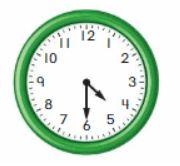
Explanation :
In the above clock the time is 4 hours 30 minutes.
But the time in remaining three is 3 hours 3 minutes.
So, it does not belong with the other three.
Lesson 14.8 Tell Time to the Nearest Five Minutes
Explore and Grow
Label the missing minutes around the clock. Then tell the time.
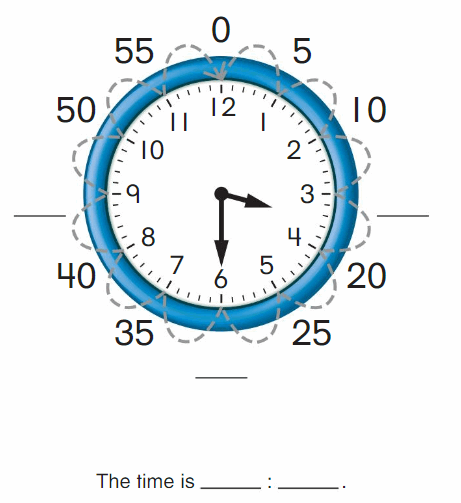
Answer:
- 15
- 30
- 55.
- The time is 3 hours 30 minutes
Show and Grow
Write the time.
Question 1.
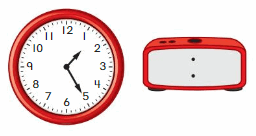
Answer: 1 hours 25 minutes.
Explanation:
As the hours hand is in between 1 and 2 and the minutes hand on 5. So, the time is on 25 minutes.
That means, the time is 1 hours and 25 minutes.
Question 2.
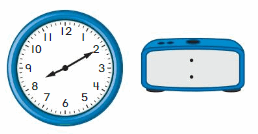
Answer:8 hours 10 minutes.
Explanation:
As the hours hand is on 8 and the minutes hand on 10. So, the time is on 10 minutes.
That means, the time is 8 hours and 10 minutes.
Question 3.
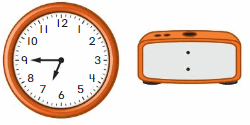
Answer: 6 hours 45 minutes.
Explanation:
As the hours hand is in between 6 and 7 and the minutes hand on 9. So, the time is on 45 minutes.
That means, the time is 6 hours and 45 minutes.
Question 4.
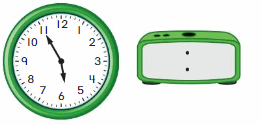
Answer: 5 hours 55 minutes.
Explanation:
As the hours hand is in between 5 and 6 and the minutes hand on 11. So, the time is on 55 minutes.
That means, the time is 5 hours and 55 minutes.
Apply and Grow: Practice
Write the time.
Question 5.
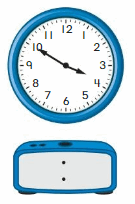
Answer: 3 hours 50 minutes.
Explanation:
As the hours hand is in between 3 and 4 and the minutes hand on 10. So, the time is on 50 minutes.
That means, the time is 3 hours and 50 minutes.
Question 6.
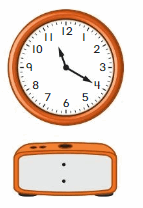
Answer: 11 hours 20 minutes.
Explanation:
As the hours hand is in between 11 and 12 and the minutes hand on 4. So, the time is on 20 minutes.
That means, the time is 11 hours and 20 minutes.
Question 7.
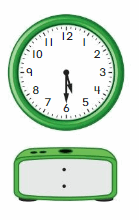
Answer: 5 hours 30 minutes.
Explanation:
As the hours hand is in between 5 and 6 and the minutes hand on 6. So, the time is on 30 minutes.
That means, the time is 5 hours and 30 minutes.
Draw to show the time.
Question 8.
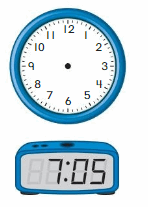
Answer: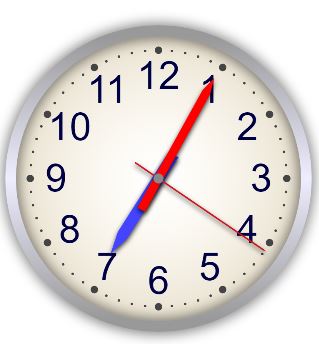
Question 9.
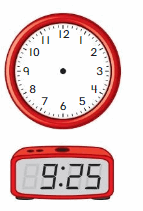
Answer:
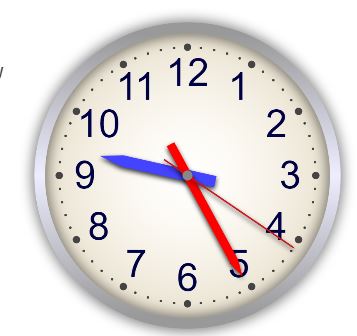
Question 10.
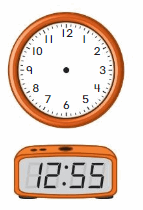
Answer:
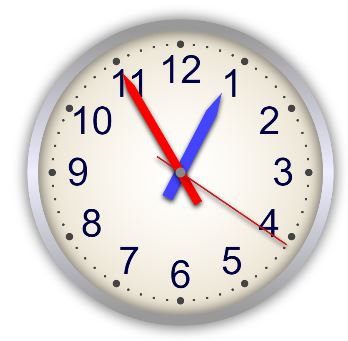
Question 11.
Patterns
Write the next time in the pattern.

Answer:
8:30
The sequence is differ by 5 minutes
Question 12.
Precision
The hour hand points between the 4 and the 5. The minute hand points to the 4. What time is it?

Answer:
As the hour hand points between 4 and 5 .the minute hand points to the 4
The time is 4 hours 20 minutes
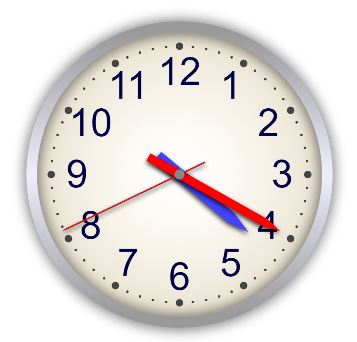
Think and Grow: Modeling Real Life
Baseball practice lasts 40 minutes. Show and write the time practice ends.
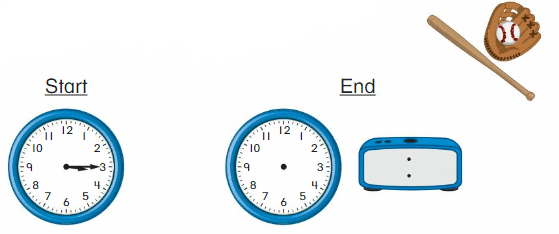
Answer: 3 hours 55 minutes
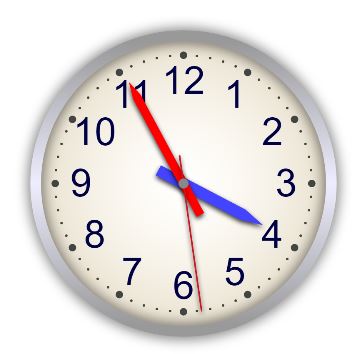
Show and Grow
Question 13.
Recess lasts 25 minutes. Show and write the time recess ends.
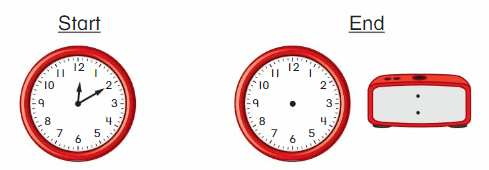
Answer: 12 hours 35 minutes
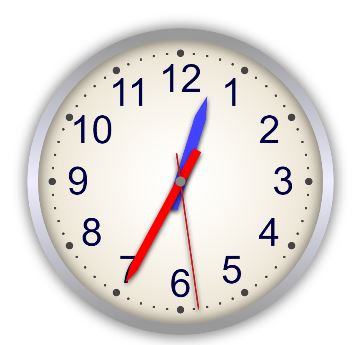
Question 14.
DIG DEEPER!
A train ride starts at 6:40. The ride lasts 45 minutes. What time does the ride end?
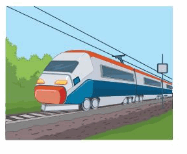

Answer: 7 hours 25 minutes
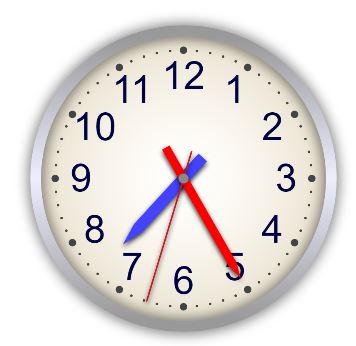
Tell Time to the Nearest Five Minutes Homework & Practice 14.8
Write the time.
Question 1.
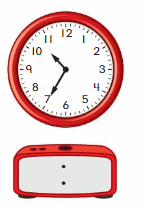
Answer:
10 hours 35 minutes.
As the hours hand is in between 10 and 11 and the minutes hand is near to 7. So, the time is near to 35 minutes.
That means, the time is 10 hours and 35 minutes.
Question 2.
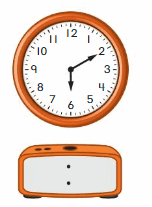
Answer:
6 hours 10 minutes.
As the hours hand is on 6, the minutes hand is on 2. So, the time is near to 10 minutes.
That means, the time is 6 hours and 10 minutes.
Question 3.
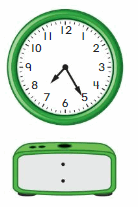
Answer:
7 hours 25 minutes.
As the hours hand is in between 7 and 8 and the minutes hand is near to 5. So, the time is near to 25 minutes.
That means, the time is 7 hours and 25 minutes.
Question 4.
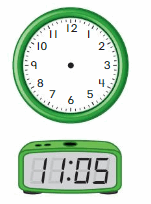
Answer: 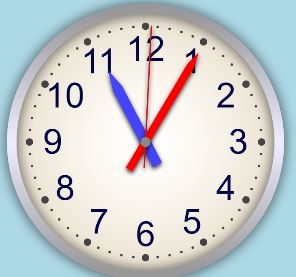
Question 5.
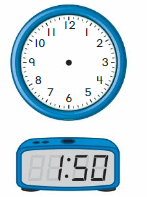
Answer:
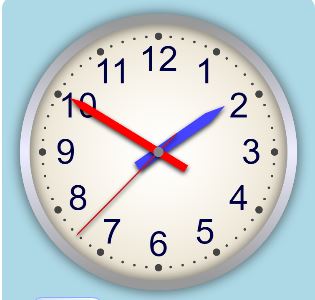
Question 6.
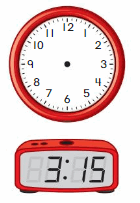
Answer:
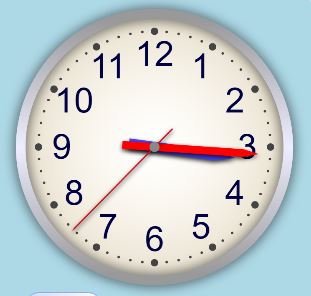
Question 7.
Reasoning
The minute hand points to the 7. What number will it point to in 10 minutes?
Answer : 9
Each number the minutes hand points, indicates 5 minutes.
So,10 minutes indicates 2 more numbers, the minutes hand moves on to.
That means, 7 + 2 = 9.
So, after 10 minutes, the minutes hand points on to 9.
Question 8.
Precision
The hour hand points between the 11 and the 12. In 25 minutes it will be the next hour. What time is it now?
Answer: 11 hours 35 minutes.
Explanation:
Each number the minutes hand point, indicates 5 minutes.
So, 25 minutes indicates 5 more numbers, the minutes hand moves on to.
that means ,5 x 5 = 25
So, after 25 minutes, the time is 12: 00
now, the time is 11 hours 35 minutes .
Question 9.
Modeling Real Life
Your walk to school lasts 15 minutes. Show and write the time your walk ends.

Answer: 8 hours 25 minutes
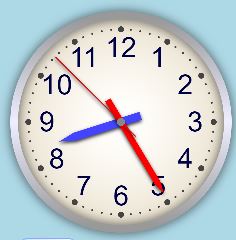
Question 10.
DIG DEEPER!
Your swimming lesson starts at 5:30. It lasts 35 minutes. What time does the lesson end?

Answer:
6 hours 5 minutes.
Explanation:
Each number the minutes hand points, indicates 5 minutes.
So,35 minutes indicates 7 more numbers, the minutes hand moves on to.
That means, 7 x 5= 35
So, after 35 minutes, the lesson ends on 6 hours 5 minutes.
Review & Refresh
Question 11.
The crayon is about 7 centimeters long. What is the best estimate of the length of the toothpick?

Answer: 4 Centimeters.
Explanation:
Given,
The length of crayon is 7 meters long.
4 centimeters is the best estimate of length of the toothpick .
Lesson 14.9 Tell Time Before and After the Hour
Explore and Grow
Write each time on the digital clocks. How much time has passed?

Answer:
1) the time is 11hours 45 minutes
2) the time is 12: 00
on comparing both the clocks 15 minutes time has been passed.
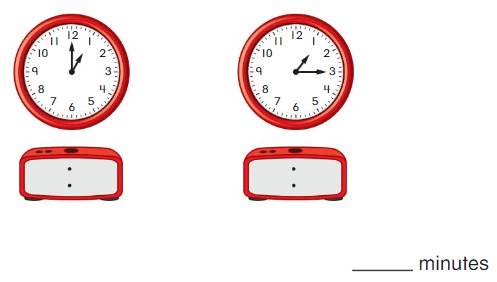
Answer:
1) In the first clock the time is 1:00
2) In the second clock the time is 1:15 on comparing both the clocks 15 minutes has been passed
Show and Grow
Write the time. Circle another way to say the time.
Question 1.
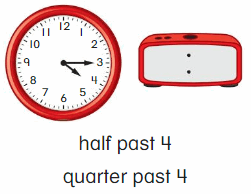
Answer:
4 hours 15 minutes.
As the hours hand is in between 4 and 5 and the minutes hand on 3 . So, the time is near to 15 minutes.
That means, the time is 4 hours and 15 minutes.
Also known as quarter past 4.
Question 2.
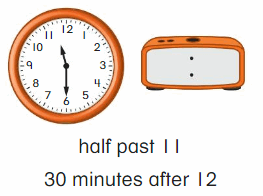
Answer:
11 hours 30 minutes.
As the hours hand is in between 11 and 12 and the minutes hand is on 6. So, the time is near to 30 minutes.
That means, the time is 11 hours and 30 minutes.
Also known as half past 11.
Question 3.
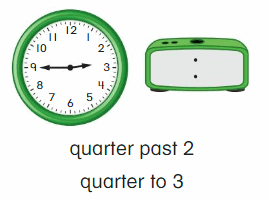
Answer:
2 hours 45 minutes.
As the hours hand is in between 2 and 3 and the minutes hand is near to 9. So, the time is near to 45 minutes.
That means, the time is 2 hours and 45 minutes.
Also known as quarter to 3.
Question 4.
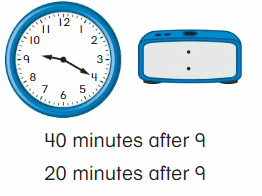
Answer:
9 hours 20 minutes.
As the hours hand is in between 9 and 10 and the minutes hand is near to 4. So, the time is near to 20 minutes.
That means, the time is 9 hours and 20 minutes.
also known as 20 minutes after 9.
Apply and Grow: Practice
Write the time. Circle another way to say the time.
Question 5.
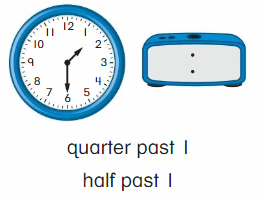
Answer: 1 hours 30 minutes.
As the hours hand is in between 1 and 2 and the minutes hand is near to 6. So, the time is near to 30 minutes.
That means, the time is 1 hours and 30 minutes.
Also known as half past 1.
Question 6.
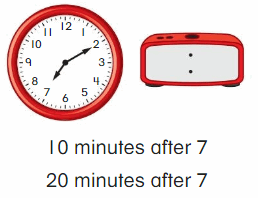
Answer:
7 hours 10 minutes.
As the hours hand is in between 7 and 8 and the minutes hand is near to 2. So, the time is near to 10 minutes.
That means, the time is 7 hours and 10 minutes.
also known as ,10 minutes after 7
Show and write the time.
Question 7.
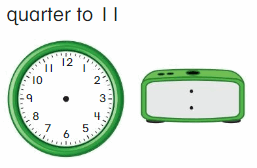
Answer: 10 : 45
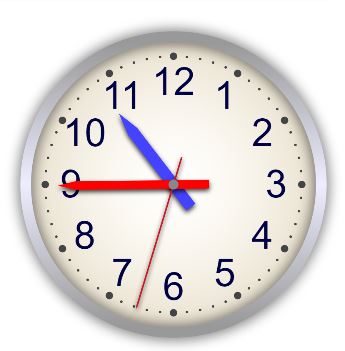
Question 8.
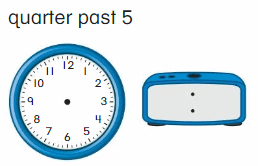
Answer: 5 hours 15 minutes
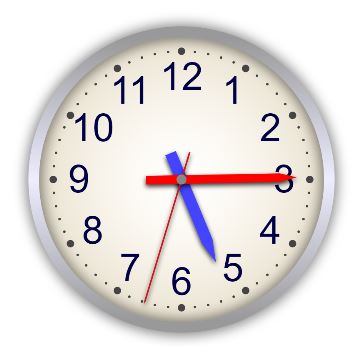
Question 9.
Which One Doesn’t Belong? Which time does not belong with the other three?

Answer: Quarter past 7
Explanation:
6 : 45
45 minutes after 6 means 6 :45
Quarter to 7 means 6 : 45
These three are same .
But , quarter past 7 means 7 : 30
So, quarter past 7 is different.
Question 10.
Precision
Is it time for homework or dinner?

Answer: Dinner
Quarter after 6 is also known as 6 hours 15 minutes.
6: 15 p.m.- dinner
Think and Grow: Modeling Real Life
School starts at quarter past 8. Are you early or late to school? Explain.


Answer:
Early to school
now, the time is 7 hours 55 minutes
the school starts at 8 hours 15 minutes ;it means quarter past 8 .
so, I am early to school
Show and Grow
Question 11.
A movie starts at quarter to 6. Are you early or late to the movie? Explain.


Answer:
I am late to the movie .
Now, the time is 6 hours 5 minutes .
but, the movie starts at quarter to 6
which means , 5 hours 45 minutes
so I am late to the movie .
Question 12.
DIG DEEPER!
You arrive at the bus station 20 minutes before 12. Which is the first bus you can board? How many minutes are there until it leaves?


Answer:
The time when i arrived bus station is 11 hours 40 minutes
So, I can board blue bus.
Blue bus leaves at 11 hours 55 minutes .
So , there are 15 more minutes until the blue bus leaves the bus station.
Tell Time Before and After the Hour Homework & Practice 14.9
Write the time. Circle another way to say the time.
Question 1.
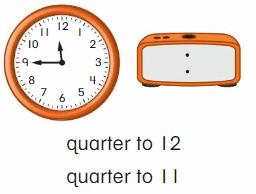
Answer: quarter to 12 means 11 hours 45 minutes
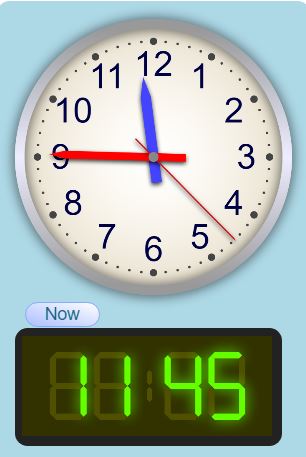
As the hours hand is between 11 and 12, the minutes hand is on 9. So, the time is near to 45 minutes.
That means, the time is 11 hours and 45 minutes.
Question 2.
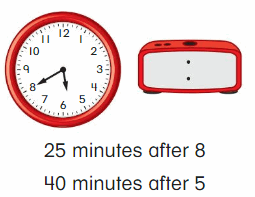
Answer: 40 minutes after 5 which means 5 hours 40 minutes
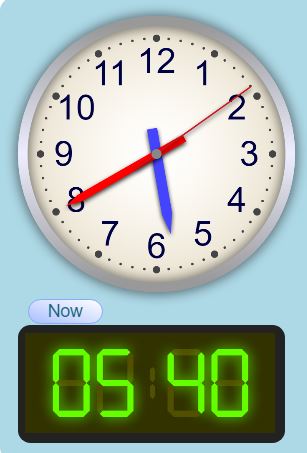
As the hours hand is between 5 and 6, the minutes hand is on 8. So, the time is near to 40 minutes.
That means, the time is 5 hours and 40 minutes.
Show and write the time.
Question 3.
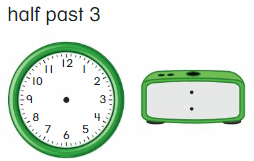
Answer: 3 hours 30 minutes
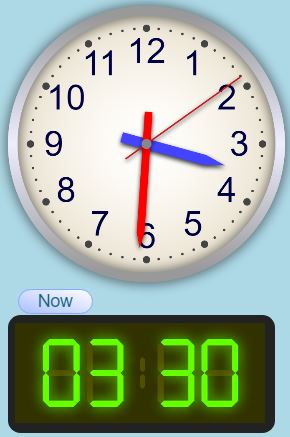
As the hours hand is between 3 and 4, the minutes hand is on 6. So, the time is near to 30 minutes.
That means, the time is 3 hours and 30 minutes.
Question 4.
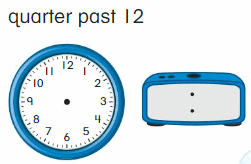
Answer: 12 hours 15 minutes
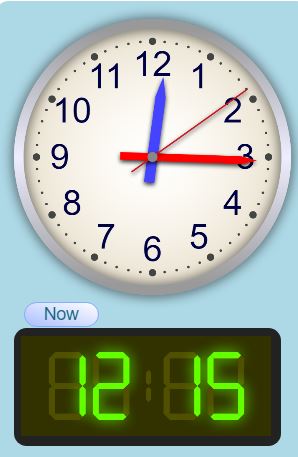
As the hours hand is between 12 and 1, the minutes hand is on 3. So, the time is near to 15 minutes.
That means, the time is 12 hours and 15 minutes.
Question 5.
YOU BE THE TEACHER
Newton says it is 2:45, or quarter to 3. Is he correct? Explain.

Answer:
Yes, he is correct.
Explanation:
quarter means 15 minutes .
Each number the minutes hand points, indicates 5 minutes.
That means, 3 x 5= 15
so, 2:45 and quarter to 3 are both same
So, newton is correct
Question 6.
Modeling Real Life
A show starts at quarter to 7. Are you early or late to the show? Explain.

Answer:
I am early to the show
Now ,the time is 6 hours 30 minutes
but the show starts at quarter to 7 which means 6 hours 45 minutes
So ,I am 15 minutes early to the show
Question 7.
DIG DEEPER!
You arrive at the metro station 10minutes after 2. Which is the first train you can board? How many minutes are there until it leaves?

Answer:
The time 10 minutes after 2 is 2 hours 10 minutes
So ,I can board the yellow train which will leaves the railway station at 2: 30
There are 20 minutes more until the yellow train leaves the railway station.
Review & Refresh
Question 8.

Answers: 162.

Question 9.

Answer: 177
Explanation:

Question 10.

Answer: 446.
Explanation:

Lesson 14.10 Relate A.M. and P.M.
Explore and Grow
Describe what you do in the morning. Show and write the time. Describe what you do in the evening. Show and write the time.
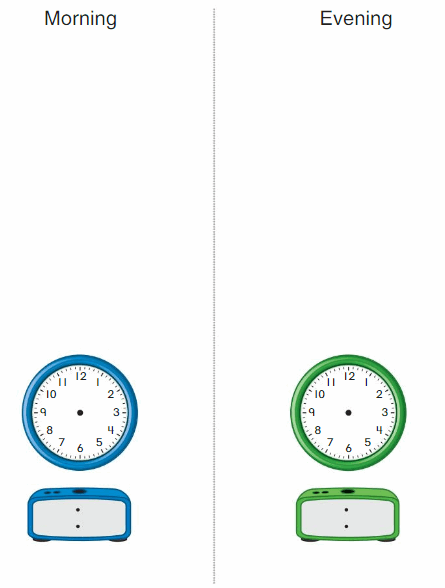
Show and Grow
Write the time. Circle a.m. or p.m.
Question 1.
Eat breakfast
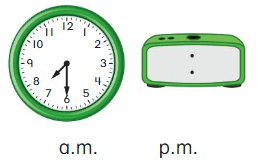
Answer: 7 hours 30 minutes a.m.
As the hours hand is on 7, the minutes hand is on 6. So, the time is near to 30 minutes.
That means, the time is 7 hours and 30 minutes.
Question 2.
Eat dinner
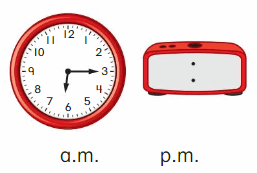
Answer:
6 hours 15 minutes p.m.
As the hours hand is between 6 and 7, the minutes hand is on 3. So, the time is near to 15 minutes.
That means, the time is 6 hours and 15 minutes.
Question 3.
Go to art class
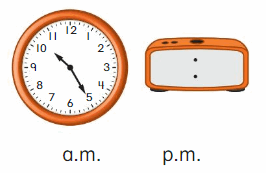
Answer :
10 hours 25 minutes a.m.
As the hours hand is between 10 and11, the minutes hand is on 5. So, the time is near to 25 minutes.
That means, the time is 10 hours and 25 minutes.
Question 4.
Do homework
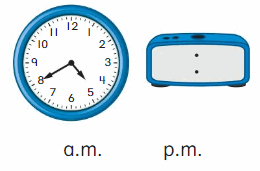
Answer:
4 hours 40 minutes p.m.
As the hours hand is between 4 and 5, the minutes hand is on 8. So, the time is near to 40 minutes.
That means, the time is 4 hours and 40 minutes.
Apply and Grow: Practice
Write the time. Circle a.m. or p.m.
Question 5.
Ride the bus to school
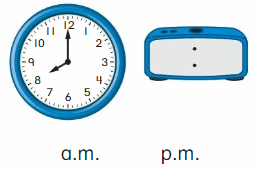
Answer:
8:00 a.m.
As the hours hand is on 8, the minutes hand is on 12.
That means, the time is 8 hours
Question 6.
Go to a party
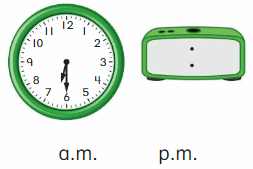
Answer:
6hours 30 minutes p.m.
As the hours hand is between 6 and 7, the minutes hand is on 6. So, the time is 30 minutes.
That means, the time is 6 hours and 30 minutes.
Draw to show the time. Circle a.m. or p.m.
Question 7.
Read before bed
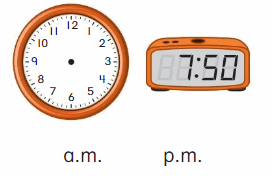
Answer:
7 hours and 50 minutes p.m.
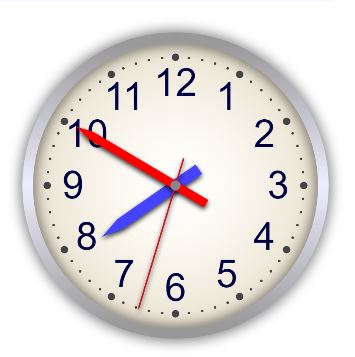
Question 8.
Sunrise
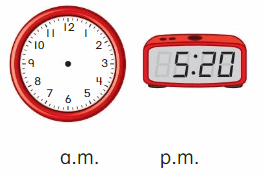
Answer:
5 hours 20 minutes a.m.
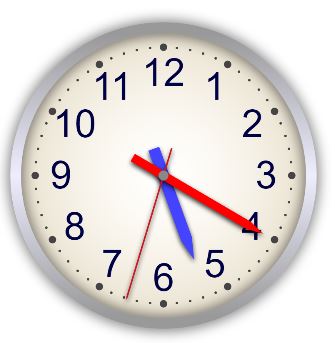
Question 9.
Reasoning
Use the times in the list to complete the story.
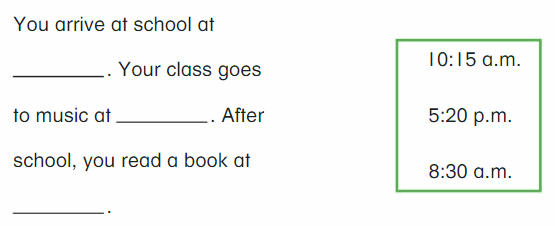
Answer:
You arrive at school at 8: 30 a.m. Your class goes to music at 10:15 a.m. After school,
you read a book at 5:20 p.m.
Think and Grow: Modeling Real Life
Use the times to complete the timeline. Write something you might do at those times.
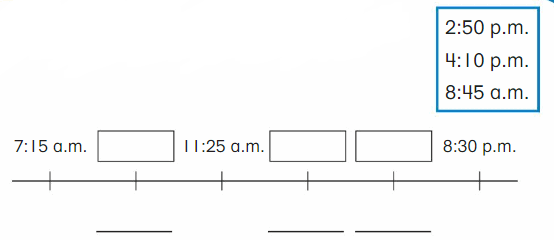
Answer:
1) 8: 45 a.m. – School time
2)2:50 p.m. – Music class time
3) 4:10 p.m. – Home work
Show and Grow
Question 10.
Use the times to complete the timeline. Write something you might do at those times.
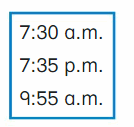

Answer:
1) 7: 30 a.m. – Yoga class
2) 9:55 a.m.- Art class
3) 7:35 p.m. – Dinner
Question 11.
DIG DEEPER!
Use the times to complete the timeline. Then rewrite each time digitally below, including a.m. or p.m
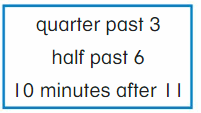

Answer:
1) 20 minutes before 7 – 6:40 a.m
2) 10 minutes after 11 – 11:10 a.m
3) noon – 12:00 p.m
4) quarter past 3 – 3:15 p.m
5) half past 6 – 6:30 p.m
6)2 0 minutes after 8 – 8:20 p.m
Relate A.M. and P.M. Homework & Practice 14.10
Write the time. Circle a.m. or p.m.
Question 1.
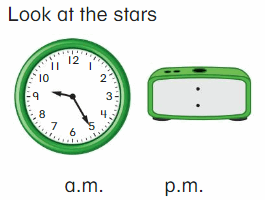
Answer:
9 hours 25 minutes p.m
As the hours hand is between 9 and 10, the minutes hand is on 5. So, the time is near to 25 minutes.
That means, the time is 9 hours and 25 minutes.
Question 2.
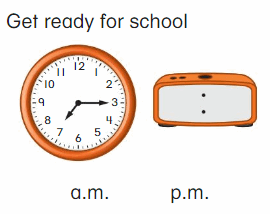
Answer:
7hours 15 minutes A.m.
As the hours hand is between 7 and 8, the minutes hand is on 3. So, the time is 15 minutes.
That means, the time is 7 hours and 15 minutes.
Draw to show the time. Circle a.m. or p.m.
Question 3.
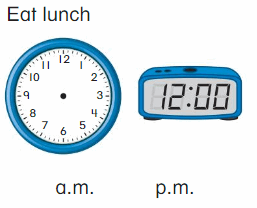
Answer: 12:00 P.m.
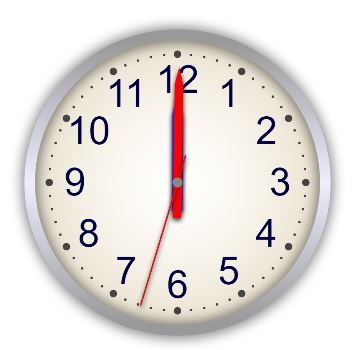
Question 4.
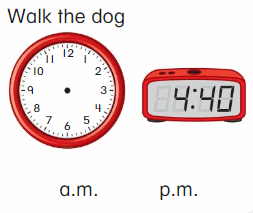
Answer: 4: 40 P.m.
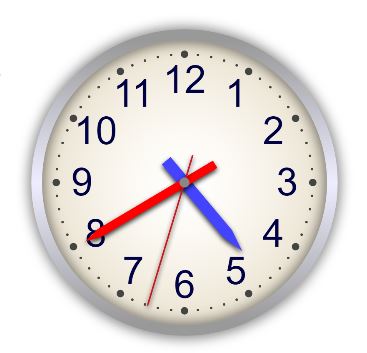
Question 5.
Reasoning
Right now, it is p.m. In 10 minutes it will be a.m. What time is it now? Explain.

Answer:
Time is 11 hours 50 minutes.
Each minute hand point indicates 5 minutes
That means 2x 5= 10 minutes
a.m. starts imediatly after 12:00 pm
So, now the time is 11: 50 p.m.
Question 6.
Modeling Real Life
Use the times to complete the timeline. Write something you might do at those times.
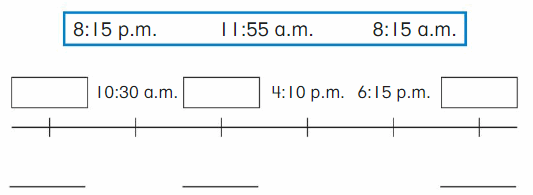
Answer:
1 ) 8:15 a.m. – break fast
2) 11: 55 a.m. – art class
3) 8: 15 p.m.- drawing time
Question 7.
DIG DEEPER!
Use the times to complete the timeline. Then rewrite each time digitally below, including a.m. or p.m.
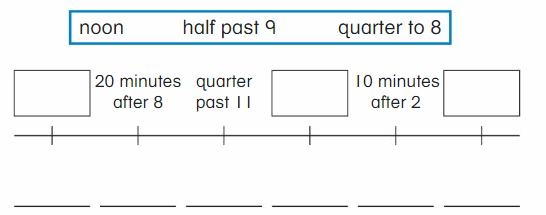
Answer:
1 ) Quarter to 8 – 7:45 a.m.
2) 20 minutes after 8 – 8: 20 a.m.
3) Quarter past 11 – 11: 15 a.m.
4) Noon – 12:00 p.m.
5) 10 minutes after 2 – 2 : 10 p.m.
6) Half past 9- 9:30 p.m.
Review & Refresh
Question 8.
65 + 36 = ____
Answer:
65 +36 = 101
Question 9.
56 + 18 = ____
Answer: 74
Money and Time Performance Task 14
Question 1.
a. You have two $1 bills, 1 quarter, 5 dimes, 3 nickels, and 2 pennies. How much more money do you need to buy a subway pass?
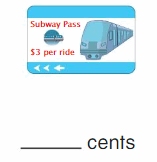
Answer:
The cost of subway pass is $3
$3 is equals to 300 cents
$1 is equals to 100 cents
Two $1 = 100 + 100 = 200cents
1 quarter = 25 cents
1 dime = 10 cents
Which means , 5 x 10 = 50
1 nickel = 5 cents
Which means, 3 x 5 = 15
and 2 pennies = 2 cents
Total : 200 +25+50+15+2 = 292
300 – 292 = 8 cents
I need 8 more cents to buy a pass.
So, I do not have enough money to buy a subway pass.
b. You find a dime. Do you have enough money to buy the pass now?
![]()
Answer: Yes
Explanation:
1 dime = 10 cents
292 +10 = 302 cents
The cost of subway pass is $3 which means 300 cents
If I find a dime, I have enough money to buy a pass
Question 2.
A weekly subway pass is $32. A customer pays with a $50 bill. Use tally marks to show three different ways that the customer can receive change. What is the total change?
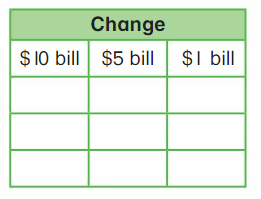
![]()
Answer:
The cost of weekly subway pass is $32 .
Given that ,
A customer paid a $50 bill
Total change :
$50 -$32 = $18
$18 can be shown as
1) 1 $10 bill , 1 $5 bill and 3 $1 bill
2) 1 $10 bill, 8 $1 bills
3) 3 $ 5 bills and 3 $1 bill .
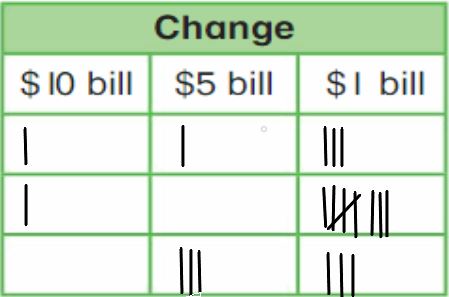
Question 3.
You arrive at the subway station at quarter to 3. What times will the subways arrive?

Answer: car A arrives subway
Money and Time Activity
To Play: Place the Flip and Find Cards face down in the boxes. Take turns flipping 2 cards. If your cards show the same time or value, keep the cards. If your cards show different times or values, flip the cards back over. Play until all matches are made.
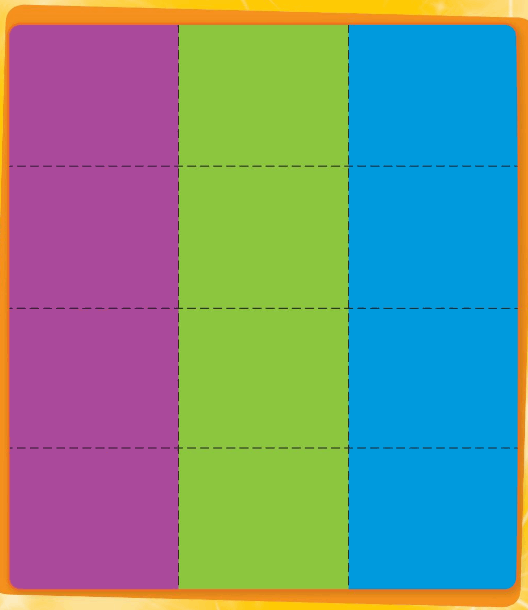
Money and Time Chapter Practice
4.1 Find Total Values of Coins
Question 1.
Count on to find the total value.

Answer: 46 cents
Explanation
1 quarter = 25 cents
1 dime = 10 cents
1 nickel = 5 cents
Which means , 5 x 2 =10 cents
1 penny = 1 cent
Total : 25 +10+5+5+1 = 46 cents
Therefore the total value of coins 46 cents.
Question 2.
Modeling Real Life
You have 2 quarters, 2 dimes, and 1 penny. How many cents do you have? Do you have enough money to buy the frozen fruit bar?
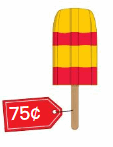
![]()
Answer:
The cost of frozen fruit bar is 75 cents
1 quarter = 25 cents
which means , 2 quarter = 2 x 25 = 50 cents
1 dime = 10 cents
which means , 2 dimes = 2 x 10 = 20 dimes
1 penny = 1 cent
total amount I have is 50+20+1 = 71 cents
therefore I have 71 cents
So ,I do not have enough money to buy the frozen fruit bar.
14.2 Order to Find Total Values of Coins
Question 3.
Draw and label the coins from the greatest value to the least value. Then find the total value.

Answer:
43 cents
Explanation
1 quarter = 25 cents
1 dime = 10 cents
1 nickel = 5 cents
3 pennies = 3cents
Total value = 25 +10 +5 + 3 = 43 cents
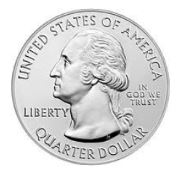 >
>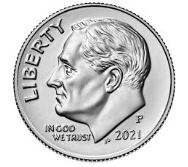 >
>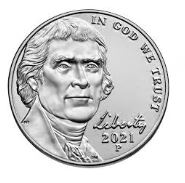 >
>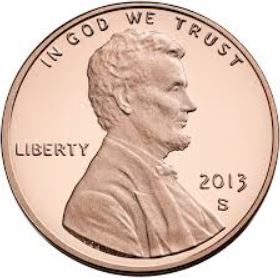
14.3 Show Money Amounts in Different Ways
Question 4.
Draw and label coins to show the amount in two different ways.

Answer:
56 cents can be shown as
2 quarter, 1 nickel and 1 penny
1 quarter = 25 cents
Which means, 2 x 25 = 50 cents
1 nickel = 5 cents
and 1 penny = 1 cents
Total : 50+5+1 = 56 cents




Another way :
56 cents can be shown as 5 dime, 1 nickel and 1 penny
1 dime = 10 cents
5 dimes = 5 x 10 = 50 cents
1 nickel = 5 cents
and 1 penny = 1 cent
Total value :
50 + 5+1 = 56 cents







14.4 Make One Dollar
Draw coins to make $1. How many cents do you need?
Question 5.
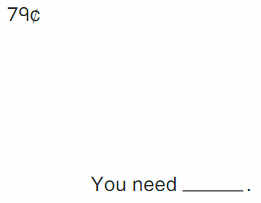
Answer: $ 1 is equals to 100 cents
100 cents – 79 cents = 21 cents.
So , I need 21 cents to make $ 1
21 cents can be shown in coins as 2 dime , 1 penny
1 dime = 10 cents
Which means , 2 dime = 2 x 10 = 20 cents
1 penny = 1 cent
Total : 20 + 1 = 21 cents



Question 6.
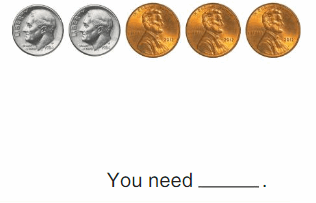
Answer:
$1 is equals to 100 cents
1 dime = 10 cents
Which means , 2 cents= 2 x 10 = 20 cents
3 pennies = 3 cents
Total value = 20+3 = 23 cents
Now, 100 cents- 23 cents = 77 cents
77 cents can be shown as 3 quarters , 2 pennies
1 quarter = 25 cents
Which means , 3 quarters = 3 x 25 = 75 cents
2 pennies = 2 cents
Total value : 75 + 2 = 77 cents





14.5 Make Change from One Dollar
Question 7.
Reasoning
Newton buys a toy for 21¢. Descartes buys one for 94¢. You buy one for 57¢. You each pay with $1. Who gets back the least amount of money? How do you know?
_____________________________________
_____________________________________
Answer:
$1 is equals to 100 cents
The cost of newtons toy is 21 cents
100 – 21 =79 cents
So, 79 cents is change newtons gets back.
Now, the cost of descartes toy is 94 cents
100 – 97 = 3 cents
So Descartes change is 3 cents
On comparing both newtons and Descartes money
79 cents is greater than 3cents;
79 > 3
Therefore, Descartes gets back the least amount of money.
14.6 Find Total Values of Bills
Question 8.
Count on to find the total value.

Answer: $ 38
Explanation :
We have , Three $ 1 bills
which means , $1 +$1 $1 = $3
One $ 5 bill
One $ 10 bill
One $ 20 bill
Total value :
$ 3+ $5 +$10 + $20 =$38
Therefore the total value of the dollar bills is $ 38.
Question 9.
Newton has five $10 bills. He has $32 more than Descartes. How much money does Descartes have?

Answer: $18
Explanation :
five $ 10 bills is equals to
5 x 10 = $ 50
Given that , Newton has $32 more than Descartes
We know that, Newton have $50
Now, $50 – $32 = $18
Therefore , Descartes have $18
14.8 Tell Time to the Nearest Five Minutes
Write the time.
Question 10.
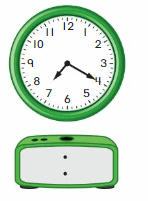
Answer: 7 hours 20 minutes
Explanation :
As the hours hand is between 7 and 8, the minutes hand is on 4. So, the time is 20 minutes.
That means, the time is 7 hours and 20 minutes.
Question 11.
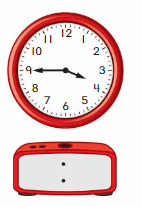
Answer: 3 hours 45 minutes
Explanation :
As the hours hand is between 3 and 4, the minutes hand is on 9. So, the time is 45 minutes.
That means, the time is 3 hours and 45 minutes.
Question 12.
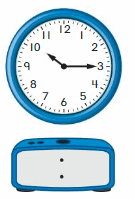
Answer: 10 hours 15 minutes
Explanation :
As the hours hand is between 10 and 11, the minutes hand is on 3. So, the time is 15 minutes.
That means, the time is 10 hours and 15 minutes.
14.9 Tell Time Before and After the Hour
Question 13.
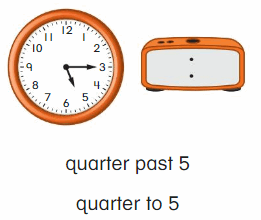
Answer: quarter past 5
which means 5 hours 15 minutes
quarter to 5 means 4 hours 45 minutes
Question 14.
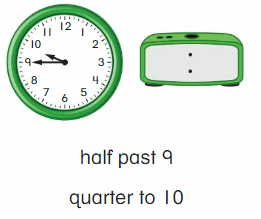
Answer: quarter to 10
which means ,9 hours 45 minutes
half past 9 means 9 hours 30 minutes
Question 15.
Modeling Real Life
Soccer practice starts at half past 1. Are you early or late to soccer practice? Explain.

Answer: I am late to soccer practice.
Explanation:
now the time is 1 hour 45 minutes .
The class starts at half past one
Which means ,1 hour 30 minutes
So ,I am late by 15 minutes to the class.
14.10 Relate A.M. and P.M.
Draw to show the time. Circle a.m. or p.m.
Question 16.
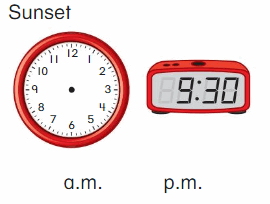
Answer : 9hours 30 minutes p.m
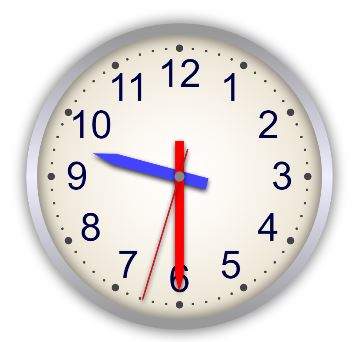
Question 17.
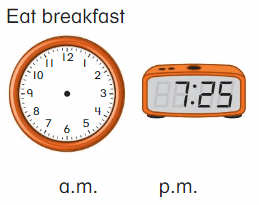
Answer:7 hours 25 minutes a.m.
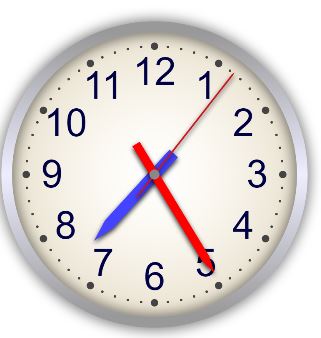
Conclusion:
Every expert’s choice is using Big Ideas Math Answers Grade 2 Chapter 14 Money and Time pdf. Compare the questions with the real-time problems and solve the questions with the help of Big Ideas Math Book Grade 2 Chapter 14 Money and Time Solutions. Stay in touch with our site https://bigideasmathanswers.com/ to find answer keys of all Big Ideas Math Grade 2 Chapters.
